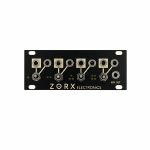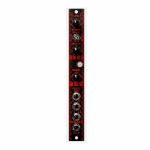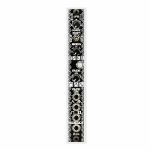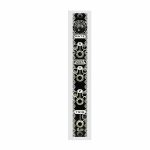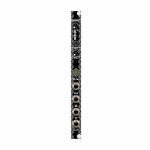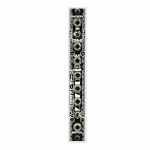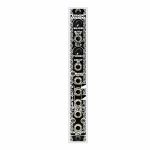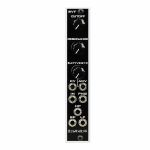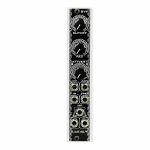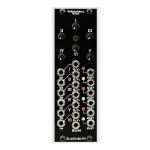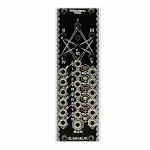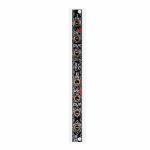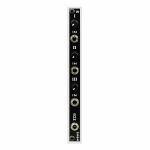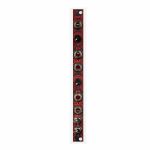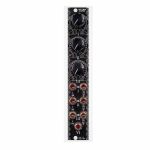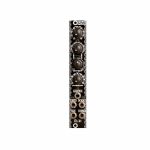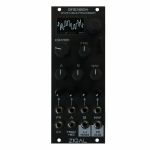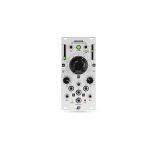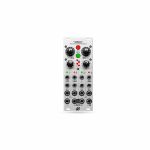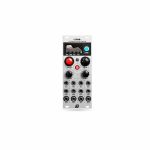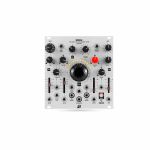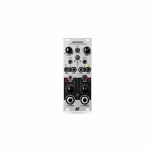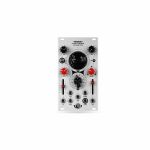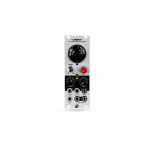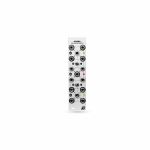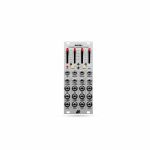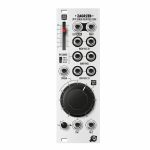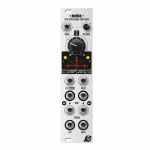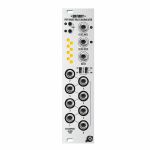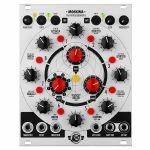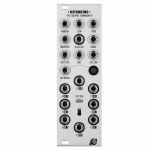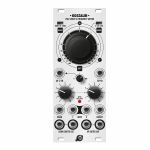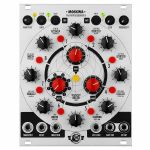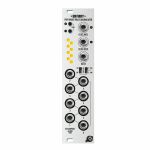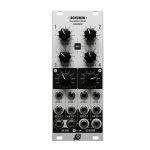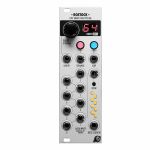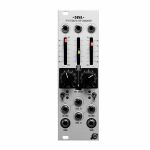100% Secure Shopping
Studio equipment
Our full range of studio equipment from all the leading equipment and software brands. Guaranteed fast delivery and low prices.
100% Secure Shopping
DJ equipment
Our full range of DJ equipment from all the leading equipment and software brands. Guaranteed fast delivery and low prices. Visit Juno DJ
Filter
Coming Soon
Equipment
Format
Release Date
Brand
Featured
Price
Tags
Notes: The Zorx 1U CV Bus is an 84 HP 4 - 1 x 4 or 2 - 1 X 8 buffered mult with attenuation/attenuverting on each output for use with audio and CV signals.
There are four channels, each with four dedicated outputs, separated into groups of four. 4X4X4. Input a signal into any channel and use that channel's outputs to spread the input signal throughout your rig. With outputs spread out in this manner, it inspires creative modulation and patching.
Channel 1's input is normalled into Channel 2's input for use as a 1x8 mult. Likewise, Channel 3's input is normalled into Channel 4's input for use as a 1x8 mult. When nothing is patched into Channels 1 and 3,+5V is fed into each input for use as an offset throughout their respective channels with a peak to peak voltage of -5V to +5V available at each output.
Each output has attenuator/attenuverter potentiometer control. Center position is off - no signal at the output. These outputs are buffered so that with one input you can have four separate and different variations of the input signal at each of its corresponding outputs.
See-thru colour coded LED indicators denote which channel an output belongs to for easy maneuvering during live performance and in dimly lit situations, and there are also numbered dots below each potentiometer that denote that as well.
The Zorx 1U CV Bus uses +12V 90 mA and -12V 90mA, and doesn't need a +5V rail to operate. It has a depth of 27mm. The faceplate is black matte with copper.
The 20 HP Zorx SILENCER 1U CV BUS Expander is also available to buddy up with the 1U CV Bus.
The Zorx 1U SILENCER is a clickless 20 HP 4 channel performance silencing module that lets you manually switch each channel on and off, thereby muting it, with latching or momentarily capabilities. There is also a MIX OUT that sums all of the SILENCER's outputs into a single mono output. A connector cable [included] can be connected from the rear of the Zorx 1U CV Bus to the rear of the SILENCER which will take the last four outputs of the Zorx 1U CV Bus and duplicate them, normalling them to the corresponding inputs of the SILENCER. This normalization can be overridden by patching an input into each channel so that the SILENCER can act on its own or in tandem with the Zorx 1U CV Bus, or a combination of the two. Illuminated numbered dots correspond to the 4 channels of the 1U CV Bus for easy recognition.
The SILENCER can be used as a 4-channel on/off/(on) performance switch, a 4-channel audio or CV mixer, or a combination of the two while having control of which channels you want in the final mix.
The SILENCER consumes +12V 40mA and -12V 40mA and has a depth of 40mm.
… Read moreThere are four channels, each with four dedicated outputs, separated into groups of four. 4X4X4. Input a signal into any channel and use that channel's outputs to spread the input signal throughout your rig. With outputs spread out in this manner, it inspires creative modulation and patching.
Channel 1's input is normalled into Channel 2's input for use as a 1x8 mult. Likewise, Channel 3's input is normalled into Channel 4's input for use as a 1x8 mult. When nothing is patched into Channels 1 and 3,+5V is fed into each input for use as an offset throughout their respective channels with a peak to peak voltage of -5V to +5V available at each output.
Each output has attenuator/attenuverter potentiometer control. Center position is off - no signal at the output. These outputs are buffered so that with one input you can have four separate and different variations of the input signal at each of its corresponding outputs.
See-thru colour coded LED indicators denote which channel an output belongs to for easy maneuvering during live performance and in dimly lit situations, and there are also numbered dots below each potentiometer that denote that as well.
The Zorx 1U CV Bus uses +12V 90 mA and -12V 90mA, and doesn't need a +5V rail to operate. It has a depth of 27mm. The faceplate is black matte with copper.
The 20 HP Zorx SILENCER 1U CV BUS Expander is also available to buddy up with the 1U CV Bus.
The Zorx 1U SILENCER is a clickless 20 HP 4 channel performance silencing module that lets you manually switch each channel on and off, thereby muting it, with latching or momentarily capabilities. There is also a MIX OUT that sums all of the SILENCER's outputs into a single mono output. A connector cable [included] can be connected from the rear of the Zorx 1U CV Bus to the rear of the SILENCER which will take the last four outputs of the Zorx 1U CV Bus and duplicate them, normalling them to the corresponding inputs of the SILENCER. This normalization can be overridden by patching an input into each channel so that the SILENCER can act on its own or in tandem with the Zorx 1U CV Bus, or a combination of the two. Illuminated numbered dots correspond to the 4 channels of the 1U CV Bus for easy recognition.
The SILENCER can be used as a 4-channel on/off/(on) performance switch, a 4-channel audio or CV mixer, or a combination of the two while having control of which channels you want in the final mix.
The SILENCER consumes +12V 40mA and -12V 40mA and has a depth of 40mm.
out of stock $345.50
Zorx Electronics 1U/3U Silencer - CV Bus Expander Module (CV bus expander module)
Cat: 940215
Zorx 1U/3U Silencer - CV Bus Expander Module in 6HP.
Notes: The Zorx 1U SILENCER is a clickless 20 HP 4 channel performance silencing module that lets you manually switch each channel on and off, thereby muting it, with latching or momentarily capabilities. There is also a MIX OUT that sums all of the SILENCER's outputs into a single mono output. A connector cable [included] can be connected from the rear of the Zorx 1U CV Bus to the rear of the SILENCER which will take the last four outputs of the Zorx 1U CV Bus and duplicate them, normalling them to the corresponding inputs of the SILENCER. Illuminated numbered dots correspond to the 4 channels of the 1U CV Bus for easy recognition.
The SILENCER can be used as a 4-channel on/off/(on) performance switch, a 4-channel audio or CV mixer, or a combination of the two while having control of which channels you want in the final mix.
The SILENCER consumes +12V 40mA and -12V 40mA and has a depth of 40mm.
Faceplate is black matte with copper.
… Read moreThe SILENCER can be used as a 4-channel on/off/(on) performance switch, a 4-channel audio or CV mixer, or a combination of the two while having control of which channels you want in the final mix.
The SILENCER consumes +12V 40mA and -12V 40mA and has a depth of 40mm.
Faceplate is black matte with copper.
out of stock $153.67
Zlob Modular Dual VCO Voltage Controlled Analogue Oscillator Module (voltage controlled analogue oscillator synth module)
Cat: 793137 Rel: 10 Nov 20
Dual voltage controlled anallogue oscillator Eurorack module
Notes: The Dual VCO is a 4hp Dual Voltage Controlled Analog Oscillator Eurorack Module available as a DIY Eurorack Kit, PCB and Panel, or Built.
Each VCO has square, triangle, and sine wave out, coarse and fine tuning controls, a control voltage input, and a switch for selecting exponential or linear cv in. When a control voltage is inserted, the fine tune control becomes an attenuator for the incoming voltage. In exponential mode, when the attenuator is fully clockwise, the VCO will track around 5 volts per octave.
There are a couple quirks to these 8038 VCOs:
Below 300Hz the waveform symmetry is slightly off. triangle waves get a little uneven in the lfo range, the sine is not completely perfect to begin with the bottom trough and in the lfo range it slopes slightly, and the square turns more trapezoidal above 1khz(see scope shots) Also it doesn't track 1 volt per octave perfectly. usually the 1st and 3rd octave will be a couple cents off.
Other than those idiosyncrasies, it is a powerful, stable dual oscillator in a small footprint with no cross talk between oscillators. It's great for: drones and beating sine or triangle waves, cross modulating itself for interesting clocks/LFOs, creating complex waveforms/timbres through lin/exp frequency modulation.
… Read moreEach VCO has square, triangle, and sine wave out, coarse and fine tuning controls, a control voltage input, and a switch for selecting exponential or linear cv in. When a control voltage is inserted, the fine tune control becomes an attenuator for the incoming voltage. In exponential mode, when the attenuator is fully clockwise, the VCO will track around 5 volts per octave.
There are a couple quirks to these 8038 VCOs:
Below 300Hz the waveform symmetry is slightly off. triangle waves get a little uneven in the lfo range, the sine is not completely perfect to begin with the bottom trough and in the lfo range it slopes slightly, and the square turns more trapezoidal above 1khz(see scope shots) Also it doesn't track 1 volt per octave perfectly. usually the 1st and 3rd octave will be a couple cents off.
Other than those idiosyncrasies, it is a powerful, stable dual oscillator in a small footprint with no cross talk between oscillators. It's great for: drones and beating sine or triangle waves, cross modulating itself for interesting clocks/LFOs, creating complex waveforms/timbres through lin/exp frequency modulation.
out of stock $153.67
Zlob Modular Skew Fade LFO Analogue Low Frequency Oscillator Module (analogue low frequency oscillator synth module)
Cat: 793139 Rel: 10 Nov 20
Analogue LFO module
Notes: The Skew-Fade LFO is a 3hp Analog Low Frequency Oscillator Eurorack Module capable of a plethora of waveforms, available as a DIY Eurorack Kit, PCB and Panel, or Built.
It has three rate settings ranging from 3 minutes and 30 seconds a cycle up to audio range at 20 hz. Triangle waves can be skewed between ramps and saws, and square waves pulse width can be adjusted from inverted triggers to triggers. The LFO's unique feature is voltage controlled cross fading through the ("Fade C.V." in) between square/shark tooth\sine waveforms provided at the "Fade Out." All outs are also influenced by the skew knob resulting in many complicated and asymmetrical possibilities at the "Fade Out." It can even be self patched(ie triangle or square into fade cv) for an extended pallet of waveforms. The "Fade C.V." in expects a bipolar voltage 10vpp to fade from square to sine with the fade pot at noon position. Bicolor led provides constant display of positive and negative voltage crossings.
… Read moreIt has three rate settings ranging from 3 minutes and 30 seconds a cycle up to audio range at 20 hz. Triangle waves can be skewed between ramps and saws, and square waves pulse width can be adjusted from inverted triggers to triggers. The LFO's unique feature is voltage controlled cross fading through the ("Fade C.V." in) between square/shark tooth\sine waveforms provided at the "Fade Out." All outs are also influenced by the skew knob resulting in many complicated and asymmetrical possibilities at the "Fade Out." It can even be self patched(ie triangle or square into fade cv) for an extended pallet of waveforms. The "Fade C.V." in expects a bipolar voltage 10vpp to fade from square to sine with the fade pot at noon position. Bicolor led provides constant display of positive and negative voltage crossings.
out of stock $72.19
Zlob Modular Diode Chaos Chaotic Voltage Generator Module (chaotic voltage generator synth module)
Cat: 793141 Rel: 10 Nov 20
Voltage generator module
Notes: Diode Chaos is a 3hp analog chaotic low frequency voltage generator Eurorack Module available as Eurorack DIY Kit, PCB and Panel, or Built Module.
It is a unique module because it has never existed as an electronic music instrument until now. The module is based on a circuit from a paper called "A simple chaotic circuit with a light-emitting diode" written by Volos, Wang, Jafari, and Kapitaniak.
Diode Chaos produces 3 phases of interrelated morphing voltages including a chaotic trigger out. The range is 20-30 seconds a cycle up to audio rate, although only the X out and TRIG out go up to audio rate. The frequency is controlled by the RATE knob. Each output exhibits different behavior at different rate settings. X,Y, and Z outs like to stay in the 4vpp range although at different RATE settings the outs can reach 10vpp. The TRIG out chaotically releases 0-10v triggers although sometimes it will spit out smaller voltage peaks.
LED soldermask windows provide constant display of positive and negative voltage crossings.
Differences between chaos and random(some quoted and summarized material from Ian Fritz's site):
Chaos is "highly irregular, but still contained within a finite region (the "strange attractor")"
Chaos occurs in 3 dimensions.
Chaos needs a non-linear element (with Diode Chaos the nonlinear element is a red LED, and the chaos is directly visible and useable at the TRIG out).
… Read moreIt is a unique module because it has never existed as an electronic music instrument until now. The module is based on a circuit from a paper called "A simple chaotic circuit with a light-emitting diode" written by Volos, Wang, Jafari, and Kapitaniak.
Diode Chaos produces 3 phases of interrelated morphing voltages including a chaotic trigger out. The range is 20-30 seconds a cycle up to audio rate, although only the X out and TRIG out go up to audio rate. The frequency is controlled by the RATE knob. Each output exhibits different behavior at different rate settings. X,Y, and Z outs like to stay in the 4vpp range although at different RATE settings the outs can reach 10vpp. The TRIG out chaotically releases 0-10v triggers although sometimes it will spit out smaller voltage peaks.
LED soldermask windows provide constant display of positive and negative voltage crossings.
Differences between chaos and random(some quoted and summarized material from Ian Fritz's site):
Chaos is "highly irregular, but still contained within a finite region (the "strange attractor")"
Chaos occurs in 3 dimensions.
Chaos needs a non-linear element (with Diode Chaos the nonlinear element is a red LED, and the chaos is directly visible and useable at the TRIG out).
1 in stock $80.43
Click for better price!
or call +44 20 7424 1960
quote 793141
quote 793141
Zlob Modular Triple Cap Chaos Chaotic Oscillator & Audio Mangler Module (chaotic oscillator & audio mangler synth module)
Cat: 793149 Rel: 10 Nov 20
Analogue noise oscillator/audio mangler module
Notes: The Triple Cap Chaos(C^3 Chaos) is a 2hp analog, chaos based, noise oscillator, pseudo ring modulator/harmonics generator, and audio mangler Eurorack module available as a DIY Eurorack kit, PCB and Panel, or built.
It is a unique module, like the Diode Chaos, because it has never existed as a musical instrument until now. There is also no other module to my knowledge that can do exactly what the Triple Cap can do. The circuit(with several modifications) is based on the paper "Simple Autonomous Chaotic Circuits" by J.C. Sprott and Jessica R. Piper. As opposed to the Diode Chaos that generates control voltage this module focuses on the audio rate.
The "Emanate" potentiometer controls the coarser overall spectrum of the chaos, from lots of activity counter clock wise up to less chaos and more of a steady oscillation. The "Width, CV ATT" potentiometer can be thought of as more of a fine control for the chaos/oscillator. When something is inserted into the "CV" in the voltage normalization from the width knob is broken and the potentiometer now acts as an attenuator for the incoming cv. The Triple Cap is not a traditional volt per octave exponential VCO, and has a sort of narrow frequency range to exploit the chaotic behavior.
It expects a +5v to -5v max signal in to modulate the chaos. The "IN" jack is an A.C. coupled input for audio in, although cv and audio can work for both the "CV" in jack and "IN." The "IN" will interfere and interact with the onboard chaotic oscillator depending on the frequency of the input, which may take some experimentation. It can create ring mod ish sounds, to added harmonics, to almost bit crushed sounds depending on the "X" or "Y" output. The "X" output is a more windy noisy sinusoidal based output and the "Y" output is more squared off and aggressive, harsher sounding output.
Some quirks about the Triple Cap: The "X" output can offset negatively or positively a little bit depending on the pot settings, but both outputs tend to stay around 10vpp. With the "Emanate" and "Width" pots all the way up the typical frequency will be around 150hz although some will reach 200hz at this setting. With the "Emanate" pot full counter clock wise "Width" pot full clock wise the frequency will be around 250hz. It is possible to send signals into the triple cap that can bring it out of the desired range causing the oscillation to cut out.
The Triple Cap has a double sided panel. meaning one side has the classic graphics and the other is Soulless with less graphics.
… Read moreIt is a unique module, like the Diode Chaos, because it has never existed as a musical instrument until now. There is also no other module to my knowledge that can do exactly what the Triple Cap can do. The circuit(with several modifications) is based on the paper "Simple Autonomous Chaotic Circuits" by J.C. Sprott and Jessica R. Piper. As opposed to the Diode Chaos that generates control voltage this module focuses on the audio rate.
The "Emanate" potentiometer controls the coarser overall spectrum of the chaos, from lots of activity counter clock wise up to less chaos and more of a steady oscillation. The "Width, CV ATT" potentiometer can be thought of as more of a fine control for the chaos/oscillator. When something is inserted into the "CV" in the voltage normalization from the width knob is broken and the potentiometer now acts as an attenuator for the incoming cv. The Triple Cap is not a traditional volt per octave exponential VCO, and has a sort of narrow frequency range to exploit the chaotic behavior.
It expects a +5v to -5v max signal in to modulate the chaos. The "IN" jack is an A.C. coupled input for audio in, although cv and audio can work for both the "CV" in jack and "IN." The "IN" will interfere and interact with the onboard chaotic oscillator depending on the frequency of the input, which may take some experimentation. It can create ring mod ish sounds, to added harmonics, to almost bit crushed sounds depending on the "X" or "Y" output. The "X" output is a more windy noisy sinusoidal based output and the "Y" output is more squared off and aggressive, harsher sounding output.
Some quirks about the Triple Cap: The "X" output can offset negatively or positively a little bit depending on the pot settings, but both outputs tend to stay around 10vpp. With the "Emanate" and "Width" pots all the way up the typical frequency will be around 150hz although some will reach 200hz at this setting. With the "Emanate" pot full counter clock wise "Width" pot full clock wise the frequency will be around 250hz. It is possible to send signals into the triple cap that can bring it out of the desired range causing the oscillation to cut out.
The Triple Cap has a double sided panel. meaning one side has the classic graphics and the other is Soulless with less graphics.
2 in stock $57.75
Click for better price!
or call +44 20 7424 1960
quote 793149
quote 793149
Zlob Modular Entropy Analogue Random Voltage & Noise Generator Module (analogue random voltage & noise generator synth module)
Cat: 793154 Rel: 09 Nov 20
Analogue random voltage & noise generator Eurorack module
Notes: Entropy is a 3hp analog random voltage and noise generator Eurorack Module available as a Eurorack DIY Kit, PCB and Panel, or Built.
It features sample/track and hold normalled to white noise with a toggle switch for selecting sample (switch right position) or track (switch left position) and hold function. There is also a PCB trimmer(at the top of the motherboard) to adjust the spread(gain) of random voltages out from "scalar" (low gain, counter clock wise) to large interval jumping(high gain, clock wise). All analog white, pink, and brown (red) noise 10vpp~(dependent on lower PCB trim). Smooth (infra red) random cv out at 10vpp with 2 range settings from wiggly with (more events, switch in left position) to almost random rise and fall envelope behavior (less events, switch in right position). White noise pcb trimmer sets the amplitude of the noise which in turn influences the rate of the infra out. LED solder mask windows indicate positive(red) and negative(blue) voltage crossings.
… Read moreIt features sample/track and hold normalled to white noise with a toggle switch for selecting sample (switch right position) or track (switch left position) and hold function. There is also a PCB trimmer(at the top of the motherboard) to adjust the spread(gain) of random voltages out from "scalar" (low gain, counter clock wise) to large interval jumping(high gain, clock wise). All analog white, pink, and brown (red) noise 10vpp~(dependent on lower PCB trim). Smooth (infra red) random cv out at 10vpp with 2 range settings from wiggly with (more events, switch in left position) to almost random rise and fall envelope behavior (less events, switch in right position). White noise pcb trimmer sets the amplitude of the noise which in turn influences the rate of the infra out. LED solder mask windows indicate positive(red) and negative(blue) voltage crossings.
out of stock $96.94
Zlob Modular Entropy Expander Analogue Random Voltage & Noise Generator Module (analogue random voltage & noise generator synth module)
Cat: 793160 Rel: 10 Nov 20
expansion
Notes: The Entropy Expander is a 3hp Analog Random Voltage Generator that expands upon the features of the Entropy Euroack Module. Available as a Eurorack DIY Kit, PCB and Panel, or Built Module.
The Entropy+Expander packs together some of the most random voltage options in 6hp. It provides a controllable "Glide"(slew) out for the S/T\H, a comparator with a controllable rate("Thrsh") of random gates("Rand Gate") out with an input to compare other waveforms(Comp In, inserting a cable into here breaks the white noise normalization), and high pass filtered white noise resulting in approximate "Blue noise" (+3db/octave) and "Violet noise"(+6db/octave) outs.
The unique part of the circuit is a voltage controlled A/B switch thats normalled to the "Rand Gate" out that's switching between the S/T\H out(left Blue led window)and Infra out(right Red led window), the Glide control also effects the S/T\H coming out of the switch so you can get really random results from the "Entropy Out." Inserting a cable into "Switch CV In" breaks the random gate normalization and lets you toggle between A/B(left S/T\H out and right Infra out, indicated by the led windows) with your own gate or trigger.
There is a jumper on the pcb to select if you want glide on the s/t\h at, Entropy out, or un-slewed operation. There is also a trimmer for setting the amplitude of the incoming signal at "Comp In" which sets the frequency range of random gates. This may have to be adjusted depending on your Entropy version.
The random gate range can also be set up more as a noise oscillator by turning the pcb trim(clockwise) up or it can be set so random gates are extremely slow(trim counter clockwise) with minutes between random gates.
… Read moreThe Entropy+Expander packs together some of the most random voltage options in 6hp. It provides a controllable "Glide"(slew) out for the S/T\H, a comparator with a controllable rate("Thrsh") of random gates("Rand Gate") out with an input to compare other waveforms(Comp In, inserting a cable into here breaks the white noise normalization), and high pass filtered white noise resulting in approximate "Blue noise" (+3db/octave) and "Violet noise"(+6db/octave) outs.
The unique part of the circuit is a voltage controlled A/B switch thats normalled to the "Rand Gate" out that's switching between the S/T\H out(left Blue led window)and Infra out(right Red led window), the Glide control also effects the S/T\H coming out of the switch so you can get really random results from the "Entropy Out." Inserting a cable into "Switch CV In" breaks the random gate normalization and lets you toggle between A/B(left S/T\H out and right Infra out, indicated by the led windows) with your own gate or trigger.
There is a jumper on the pcb to select if you want glide on the s/t\h at, Entropy out, or un-slewed operation. There is also a trimmer for setting the amplitude of the incoming signal at "Comp In" which sets the frequency range of random gates. This may have to be adjusted depending on your Entropy version.
The random gate range can also be set up more as a noise oscillator by turning the pcb trim(clockwise) up or it can be set so random gates are extremely slow(trim counter clockwise) with minutes between random gates.
1 in stock $82.50
Click for better price!
or call +44 20 7424 1960
quote 793160
quote 793160
Zlob Modular SVF 2-Pole 12DB State Variable Filter Module (2-pole 12DB state variable filter synth module)
Cat: 793163 Rel: 10 Nov 20
State variable filter module
Notes: The SVF is a 4hp 2 pole 12dB State Variable Filter Eurorack Module available as a Eurorack DIY Kit, PCB and Panel, or Built Module.
It provides Low Pass, Band Pass, and High Pass outs inspired by WASP and Thomas Henry filter topologies. The filter has 2 audio inputs, but channel 2 is jumper selectable between standard audio in or Ping-able operation. The 2019 revision also adds improved cutoff and resonance response and attenuversion through the ACV IN using the above pot. CV IN provides another unattenuated voltage input to modulate the frequency.
At the CV in, +10v will open the filter completely if the cutoff pot is CCW(counter clockwise). With the cutoff knob at noon the filter can be opened with +5v or closed with -5v. CV input at the ACV in is dependent on the CV attenuverter knob.
There are also several jumper selectable modes for max resonance, self oscillation or no oscillation based on the setting of the resonance pot. According to the jumper configuration, the filter is capable of clinical and clean, to juicy and drippy, to low pass gate sounding plonks, to screaming chaotic resonance. When set to self oscillation mode, the filter can produce a sine like wave with no input and a trapezoid like wave in the max resonance jumper setting. In max resonance mode, the filter output can exceed 10Vpp. On the newest version, there is a trimmer on the top pcb to set the lowest cutoff frequency.
The new black and white pcb/panel is reversible meaning, one side is classic (first picture) and the other side is soulless (second picture).
… Read moreIt provides Low Pass, Band Pass, and High Pass outs inspired by WASP and Thomas Henry filter topologies. The filter has 2 audio inputs, but channel 2 is jumper selectable between standard audio in or Ping-able operation. The 2019 revision also adds improved cutoff and resonance response and attenuversion through the ACV IN using the above pot. CV IN provides another unattenuated voltage input to modulate the frequency.
At the CV in, +10v will open the filter completely if the cutoff pot is CCW(counter clockwise). With the cutoff knob at noon the filter can be opened with +5v or closed with -5v. CV input at the ACV in is dependent on the CV attenuverter knob.
There are also several jumper selectable modes for max resonance, self oscillation or no oscillation based on the setting of the resonance pot. According to the jumper configuration, the filter is capable of clinical and clean, to juicy and drippy, to low pass gate sounding plonks, to screaming chaotic resonance. When set to self oscillation mode, the filter can produce a sine like wave with no input and a trapezoid like wave in the max resonance jumper setting. In max resonance mode, the filter output can exceed 10Vpp. On the newest version, there is a trimmer on the top pcb to set the lowest cutoff frequency.
The new black and white pcb/panel is reversible meaning, one side is classic (first picture) and the other side is soulless (second picture).
1 in stock $147.22
Click for better price!
or call +44 20 7424 1960
quote 793163
quote 793163
Zlob Modular Mineq Simple 3-Band Equaliser Module (simple 3-band equaliser synth module)
Cat: 793166 Rel: 10 Nov 20
3-band Equalizer Eurorack module
Notes: The MinEq is a 2hp simple 3 Band Equalizer Eurorack Module available as a Eurorack DIY Kit, PCB and Panel, or Built Module.
It provides boost or cut control over the Low, Mid and High frequency bands of an audio input. The circuit is capable of up to 20vpp~ of boost(with a 10vpp signal) and attenuation down to 1-2vpp depending on the input. The frequency bands are centered near 50Hz(Low), 1kHz(Mid), and 10kHz(High). The circuit is AC coupled and will invert the input. With all the potentiometers at noon, the MinEq passes the signal relatively unaltered. The only SMD component is the IC.
… Read moreIt provides boost or cut control over the Low, Mid and High frequency bands of an audio input. The circuit is capable of up to 20vpp~ of boost(with a 10vpp signal) and attenuation down to 1-2vpp depending on the input. The frequency bands are centered near 50Hz(Low), 1kHz(Mid), and 10kHz(High). The circuit is AC coupled and will invert the input. With all the potentiometers at noon, the MinEq passes the signal relatively unaltered. The only SMD component is the IC.
out of stock $56.72
Zlob Modular Vnicursal VCA 6-Channel Voltage Controlled Amplifier Module (6-channel voltage controlled amplifier synth module)
Cat: 793167 Rel: 10 Nov 20
6-channel VCA module
Notes: A whopping six channels of VCA action in just 8hp of rack space. DC-coupled linear VCAs based on the LM13700 OTA. Normalled to act as a summing mixer. Very nice.
Supplier's Notes:
The VnIcursal VCA is an 8hp 6 Channel VCA Eurorack Module available as a Eurorack DIY Kit, PCB and Panel, or Built Module.
It the smallest, most compact Voltage Controlled Amplifier in the Eurorack market. It provides 6 OTA(LM13700)-based DC Coupled Linear VCAs for Audio or CV. The 6 VCAs are summed together so it can be used as a voltage controlled mixer. Each VCA is normalled to the sum so they can be removed from the mix and used on their own. The potentiometers control the amount of gain, and when a voltage is inserted into the CV in the potentiometers act as attenuators. With a control voltage of 5 volts the VCA will be at unity gain, anything above that can clip the input. LED brightness with or without CV in provides constant feedback of each channels amount of gain.
The VnIcursal is not a perfect scientifically spec'd VCA. Analog VCAs can only close so much, or be so silent. In certain situations based on power supplies and gain stages the VCA can experience some bleed or noise mainly at the sum out as all channels are passively summed then buffered.
… Read moreSupplier's Notes:
The VnIcursal VCA is an 8hp 6 Channel VCA Eurorack Module available as a Eurorack DIY Kit, PCB and Panel, or Built Module.
It the smallest, most compact Voltage Controlled Amplifier in the Eurorack market. It provides 6 OTA(LM13700)-based DC Coupled Linear VCAs for Audio or CV. The 6 VCAs are summed together so it can be used as a voltage controlled mixer. Each VCA is normalled to the sum so they can be removed from the mix and used on their own. The potentiometers control the amount of gain, and when a voltage is inserted into the CV in the potentiometers act as attenuators. With a control voltage of 5 volts the VCA will be at unity gain, anything above that can clip the input. LED brightness with or without CV in provides constant feedback of each channels amount of gain.
The VnIcursal is not a perfect scientifically spec'd VCA. Analog VCAs can only close so much, or be so silent. In certain situations based on power supplies and gain stages the VCA can experience some bleed or noise mainly at the sum out as all channels are passively summed then buffered.
out of stock $225.86
Zlob Modular Dual VCA Dual Summed Voltage Controlled Amplifier Module (dual summed voltage controlled amplifier synth module)
Cat: 793170 Rel: 10 Nov 20
2-channel Voltage controlled amplifier/mixer module
Notes: The Dual VCA is a 2hp 2 channel Analog VCA and Mixer Eurorack Module available as a Eurorack DIY Kit, PCB and Panel, or Built Module.
It is a DC coupled OTA(LM13700) Dual Linear VCA based on the same fabled design of the VnIcursal VCA. The 2 VCAs are summed together so it can be used as a voltage controlled mixer at the "SUM OUT" or all 3 outs can be used separately and simultaneously. 5 volts into the CV in will provide unity gain, anything above 5 volts can clip the input.
… Read moreIt is a DC coupled OTA(LM13700) Dual Linear VCA based on the same fabled design of the VnIcursal VCA. The 2 VCAs are summed together so it can be used as a voltage controlled mixer at the "SUM OUT" or all 3 outs can be used separately and simultaneously. 5 volts into the CV in will provide unity gain, anything above 5 volts can clip the input.
2 in stock $86.62
Click for better price!
or call +44 20 7424 1960
quote 793170
quote 793170
Zlob Modular Push VCA Dual Summed Mute Module (dual summed mute synth module)
Cat: 793173 Rel: 10 Nov 20
Dual summed mute Eurorack module
Notes: The Push VCA is a 2hp 2 Channel DC Coupled Mute Eurorack Module available as a Eurorack DIY Kit, PCB and Panel, or Built Module.
It features 2 independent unity gain DC coupled VCAs with led push button mutes. A mix of both channels is available at the sum, but all outputs are available simultaneously. The newest version has normalizations to +5v, so with nothing plugged into the ins voltage can be toggled on and off at the outputs and up to 10 volts can be output at the sum. At checkout specify if you want latching or momentary push buttons. led button color may vary between red and yellow. but it will always be 2 of the same color.
… Read moreIt features 2 independent unity gain DC coupled VCAs with led push button mutes. A mix of both channels is available at the sum, but all outputs are available simultaneously. The newest version has normalizations to +5v, so with nothing plugged into the ins voltage can be toggled on and off at the outputs and up to 10 volts can be output at the sum. At checkout specify if you want latching or momentary push buttons. led button color may vary between red and yellow. but it will always be 2 of the same color.
out of stock $71.16
Zlob Modular Minimix User Configurable 3-Channel Mixer Module (user configurable 3-channel mixer synth module)
Cat: 793175 Rel: 10 Nov 20
3-channel user configurable mixer module
Notes: Minimix is a Simple 2hp 3 Channel Unity Gain Audio or Control Voltage Mixer Eurorack Module available as a Eurorack DIY Kit, PCB and Panel, or Built Module.
Version 2 adds jumper selectable AC or DC coupling and linear or logarithmic operation for each channel. The newly revised MiniMix is now all through hole and aimed more to the beginner solderer. There is also a trimmer on the PCB to increase the master gain up to 2 or more for all 3 channels.
The module ships with a black and white reversible pcb panel.
… Read moreVersion 2 adds jumper selectable AC or DC coupling and linear or logarithmic operation for each channel. The newly revised MiniMix is now all through hole and aimed more to the beginner solderer. There is also a trimmer on the PCB to increase the master gain up to 2 or more for all 3 channels.
The module ships with a black and white reversible pcb panel.
out of stock $73.23
Zlob Modular Miniatt Dual Summed Mute Attenuator Module (dual summed mute attenuator synth module)
Cat: 793177 Rel: 10 Nov 20
Dualsummed mute attenuator module
Notes: MiniAtt is a 2hp Dual Passive Attenuator, Offset Generator, Mixer, and Mute Eurorack Module available as a Eurorack DIY Kit, PCB and Panel, or Built Module.
The newest 666 version can be powered and will provide Offset of 0-5V with nothing plugged into the "IN" for each channel controlled by each respective Potentiometer. The "Sum Out" will also be able to send out 0-10v~ volts depending on the setting of each Potentiometer. Both channels are normalled to the sum, so inserting a signal into an "IN" will remove it from the "Sum Out. There will be signal loss at the sum out, because the module is passive. Great for cv or audio although the module ships with linear pots.
Can be used Passively or Powered.
BOM:
2 b100k song huei(tall trim pots)
2 dailywell switches sub-mini toggle spdt(on-on)
2 100k 1/4 watt 5% or 1% resistors
5 qingpu jacks(thonkiconn style)
… Read moreThe newest 666 version can be powered and will provide Offset of 0-5V with nothing plugged into the "IN" for each channel controlled by each respective Potentiometer. The "Sum Out" will also be able to send out 0-10v~ volts depending on the setting of each Potentiometer. Both channels are normalled to the sum, so inserting a signal into an "IN" will remove it from the "Sum Out. There will be signal loss at the sum out, because the module is passive. Great for cv or audio although the module ships with linear pots.
Can be used Passively or Powered.
BOM:
2 b100k song huei(tall trim pots)
2 dailywell switches sub-mini toggle spdt(on-on)
2 100k 1/4 watt 5% or 1% resistors
5 qingpu jacks(thonkiconn style)
out of stock $40.43
Zlob Modular Attenumixer 3-Channel Summed Attenuator Module (3-channel summed attenuator synth module)
Cat: 793178 Rel: 10 Nov 20
3-channel summed passive attenuator module
Notes: The Attenumixer is a 4hp 3 channel Passive Attenuator and Mixer Eurorack Module available as a Eurorack DIY Kit, PCB and Panel, or Built Module.
Each channel is normalled to the sum(VI) so it can be used as a 2 channel mixer and 1 channel attenuator, or a 3 channel mixer, or as 3 separate attenuators. Normalization to the sum is broken by inserting a jack into the outs of channels I-III. The Attenumixer works well with both cv and audio, although the potentiometers have a linear response. Since the module is passive there will be signal loss at the sum out.
Width: 4hp
Panel Material: Aluminum PCB
Current Consumption: 0mA
Depth:
Ships with M3 black nylon screws
Build Difficulty: Beginner
Expandable: no
BOM:
3 alpha round shaft(or similar)b100k potentiometers
3 knobs
3 100k 1/4 watt 5%(or 1%) resistors
7 qingpu jacks with nuts (thonkiconn style)
… Read moreEach channel is normalled to the sum(VI) so it can be used as a 2 channel mixer and 1 channel attenuator, or a 3 channel mixer, or as 3 separate attenuators. Normalization to the sum is broken by inserting a jack into the outs of channels I-III. The Attenumixer works well with both cv and audio, although the potentiometers have a linear response. Since the module is passive there will be signal loss at the sum out.
Width: 4hp
Panel Material: Aluminum PCB
Current Consumption: 0mA
Depth:
Ships with M3 black nylon screws
Build Difficulty: Beginner
Expandable: no
BOM:
3 alpha round shaft(or similar)b100k potentiometers
3 knobs
3 100k 1/4 watt 5%(or 1%) resistors
7 qingpu jacks with nuts (thonkiconn style)
out of stock $47.19
Zlob Modular VC F3DB VC Fixed Filter Module With Distortion & Feedback (eurorack distortion/dual & stereo/envelope follower/equaliser/filter module)
Cat: 840188 Rel: 11 Aug 21
A 16hp 6-channel VC fixed filter bank, with lots of clipping/distortion and self oscillation/feedback
Notes: VC F3DB stands for Voltage Controlled Fixed Filter Feedback Distortion Bank. The simplest description is it's a 6 band voltage controlled fixed filter bank. But with the additions of so much gain, clipping, feedback, and self-oscillation it becomes a very flexible and unique sound sculpting tool capable of; graphic equalization over 6 octaves, multi-band distortion, spectral processing, crude vocoding, self modulation, and even as an instrument on its own. With no input it can be used as a pseudo chaotic "harmonic" feedback oscillator.
… Read moreout of stock $408.40
Zlob Modular Foldiplier Odd/Even Harmonics Generator Module (frequency divider/waveshaper synth module)
Cat: 964623 Rel: 05 Oct 23
Odd/even harmonics generator module with feedback - 4HP.
Notes: The Foldiplier is a 4hp odd/even harmonics generator with 2 different oscillating feedback paths. The folding core of the design originates from the odd harmonics (middle)section of the Serge Wave Multiplier. But the Foldiplier adds voltage control over the symmetry and offset as well as a switch for feedback, jumper selectable between, a transistor based oscillating fuzz inspired by the Hemmo Bazz Fuss with a lot more low harmonic content and a passive oscillating half wave rectification circuit with more high harmonic content. When these feedback oscillations mix with an incoming waveform some unpredictable and unique nonlinear timbres can be achieved. The module can also be used as a no-input experimental oscillator with the feedback switch engaged. All diodes in the module are silicon.
The Fold knob controls the amount of times the waveform is folded in on its self (indicated by the red led window below the knob). The C.V. knob below is an attenuator for incoming control voltage corresponding to the Fold jack(indicated by the red led window above the jack, it only responds to positive voltage). So, the Fold knob acts like an initial amount of folding depending on its position. For example, with the Fold knob fully clockwise you can get even more folds with a control voltage in at the Fold jack. The Offset knob controls how much positive DC voltage(0 to 5v, clockwise) or negative(0 to -5v counter clockwise) DC voltage(indicated by the led window above the Offset jack, red for positive, yellow for negative) injected into the waveform via the Symmetry knob. With the Offset knob position at noon(0v) there will little effect from the Symmetry knob. The Offset jack is expecting +5v to -5v with knob position at noon to scan through the positive and negative voltage. The Symmetry knob controls the amount of negative or positive offset voltage(dependent on the Offset knob) mixed with the waveform(indicated by the yellow led window above the Symmetry jack). If positive voltage is mixed with incoming waveform more folds will occur on the positive troughs of the waveform, likewise, when negative voltage is introduced more folds happen on the negative troughs. This part of the circuit can also be broken down by thinking of the Offset as a voltage controlled crossfader swinging between positive and negative voltages into a VCA controlled by the Symmetry knob and jack. When a voltage is present at the Symmetry jack the Symmetry knob becomes an attenuator. The Symmetry jack only responds to positive voltage.
Width: 4hp
Panel Material: Double Sided PCB panel with Classic and Soulless
Reverse Power Protected
Current Consumption: +12v: 40mA, -12v: 35mA
Depth: 47mm or 1.75"
All through-hole build
Ships with M3 black nylon screws
Expandable: No
… Read moreThe Fold knob controls the amount of times the waveform is folded in on its self (indicated by the red led window below the knob). The C.V. knob below is an attenuator for incoming control voltage corresponding to the Fold jack(indicated by the red led window above the jack, it only responds to positive voltage). So, the Fold knob acts like an initial amount of folding depending on its position. For example, with the Fold knob fully clockwise you can get even more folds with a control voltage in at the Fold jack. The Offset knob controls how much positive DC voltage(0 to 5v, clockwise) or negative(0 to -5v counter clockwise) DC voltage(indicated by the led window above the Offset jack, red for positive, yellow for negative) injected into the waveform via the Symmetry knob. With the Offset knob position at noon(0v) there will little effect from the Symmetry knob. The Offset jack is expecting +5v to -5v with knob position at noon to scan through the positive and negative voltage. The Symmetry knob controls the amount of negative or positive offset voltage(dependent on the Offset knob) mixed with the waveform(indicated by the yellow led window above the Symmetry jack). If positive voltage is mixed with incoming waveform more folds will occur on the positive troughs of the waveform, likewise, when negative voltage is introduced more folds happen on the negative troughs. This part of the circuit can also be broken down by thinking of the Offset as a voltage controlled crossfader swinging between positive and negative voltages into a VCA controlled by the Symmetry knob and jack. When a voltage is present at the Symmetry jack the Symmetry knob becomes an attenuator. The Symmetry jack only responds to positive voltage.
Width: 4hp
Panel Material: Double Sided PCB panel with Classic and Soulless
Reverse Power Protected
Current Consumption: +12v: 40mA, -12v: 35mA
Depth: 47mm or 1.75"
All through-hole build
Ships with M3 black nylon screws
Expandable: No
1 in stock $149.54
Click for better price!
or call +44 20 7424 1960
quote 964623
quote 964623
Ziqal Audio Dimension Wavetable Oscillator Module (dual/stereo/oscillator/LFO/MIDI synth module)
Cat: 869503
Dimension is a modern, high resolution and performence eurorack wavetable oscillator.
Notes: ZIQAL is proud to present you the DIMENSION. A modern, high resolution and performence eurorack wavetable oscillator.
High resolution / Serum compatible
The Dimension wavetable engine uses 2048 samples * 256 waveforms wavetables to bring high definition tables to your system. Its wavetables reproduction precision will fit any of your audio textures needs.
Dimension is compatible with the Serum wavetables format and feature an intuitive and fast file browser, allowing you to explore thousand of already available wavetables. Just drop your favorites wavetables on its SD card and instantaneously start exploring new sonic territory.
24 voices
Dimension is capable of playing not less than 24 voices simultaneously within 10HP tanks to its embeed modern high end audio processor. Depending on the active patch mode voices can be assigned to chords polyphony or unison engine
Polyphonic stereo, Dimension, Dual or LFO modes
The Classic mode provides 4 oscillator voices panned over stereo outputs. You can control theses voices in CV programing chords or with the internal notes scaler and or feeding midi into the module.
The Dimension mode allows the waveform to be morphed across the entire module memory in an X Y fashion. As the module allows to store internally 25 wavetables of each maximum 256 waveforms. This mode allows wavetable morphing over (25*256) 6400 different waveforms.
Dual / LFO mode
Dual mode output two different wavetables on each output. LFO mode operates as the dual mode, except that the frequency range of output two is set in the subsonic range.
In any mode, voices can also be multiplied 6 times and detuned to play massive 6 voice unison. When using 4 voices it brings not less than a total of 24 voices out of your oscillator.
Specifications
Power
Supply: +12V 100mA
-12V 15mA
Mechanical
Size : 10HP
Depth : 25mm ( power connector included )
Audio processing
32bit 44.1kHz floating point
High performance anti-aliasing filter
Memory
25 internal patches / wavetables
Internal memory backup/load from SD
Display
65k colors
38400 pixels
Control / Modulation
CV -3V ... 7V
FM -8V ... +8V
Navigation "NAV" -8V ... +8V
A (Macro) -8V ... +8V
B (Macro) -8V ... +8V
Wavetables
2048 samples per waveform
16 bit
44.1kHz
256 waveforms per wavetable
Included
4 M3 hex screws
Power connectors
… Read moreHigh resolution / Serum compatible
The Dimension wavetable engine uses 2048 samples * 256 waveforms wavetables to bring high definition tables to your system. Its wavetables reproduction precision will fit any of your audio textures needs.
Dimension is compatible with the Serum wavetables format and feature an intuitive and fast file browser, allowing you to explore thousand of already available wavetables. Just drop your favorites wavetables on its SD card and instantaneously start exploring new sonic territory.
24 voices
Dimension is capable of playing not less than 24 voices simultaneously within 10HP tanks to its embeed modern high end audio processor. Depending on the active patch mode voices can be assigned to chords polyphony or unison engine
Polyphonic stereo, Dimension, Dual or LFO modes
The Classic mode provides 4 oscillator voices panned over stereo outputs. You can control theses voices in CV programing chords or with the internal notes scaler and or feeding midi into the module.
The Dimension mode allows the waveform to be morphed across the entire module memory in an X Y fashion. As the module allows to store internally 25 wavetables of each maximum 256 waveforms. This mode allows wavetable morphing over (25*256) 6400 different waveforms.
Dual / LFO mode
Dual mode output two different wavetables on each output. LFO mode operates as the dual mode, except that the frequency range of output two is set in the subsonic range.
In any mode, voices can also be multiplied 6 times and detuned to play massive 6 voice unison. When using 4 voices it brings not less than a total of 24 voices out of your oscillator.
Specifications
Power
Supply: +12V 100mA
-12V 15mA
Mechanical
Size : 10HP
Depth : 25mm ( power connector included )
Audio processing
32bit 44.1kHz floating point
High performance anti-aliasing filter
Memory
25 internal patches / wavetables
Internal memory backup/load from SD
Display
65k colors
38400 pixels
Control / Modulation
CV -3V ... 7V
FM -8V ... +8V
Navigation "NAV" -8V ... +8V
A (Macro) -8V ... +8V
B (Macro) -8V ... +8V
Wavetables
2048 samples per waveform
16 bit
44.1kHz
256 waveforms per wavetable
Included
4 M3 hex screws
Power connectors
out of stock $283.62
Xaoc Devices Katowice 1978 Stereo Variable Band Isolator Module (dynamics/equalizer/filter/VCA/dual/stereo synth module)
Cat: 797179 Rel: 10 Nov 20
Dynamics/equaliser/filter/VCA/dual & stereo synth module
Notes: Three-band isolator with stereo inputs and outputs, splitting the signal into highs, mids and lows then allowing you to control level and frequency via CV for some clever sound sculpting and modulation.
Supplier's Notes:
Katowice is a stereo variable-band isolator that allows the user to manipulate a selected range of frequencies. It is the first module in a series of upcoming Xaoc Devices products designed specifically for processing stereo signals.
Katowice splits the stereo input signal into three bands: low, middle, and high. While the knobs and CV inputs define the center frequency and bandwidth of the mid band, the low and high bands are automatically adjusted so that the sum of all three is a complete signal. All three bands are passed through high quality VCAs and their stereo outputs are available separately for further processing. A stereo mixdown signal is also available.
Katowice may be used as a crossover network, a parametric EQ, DJ-style kill filter, or other band-selective applications, including multiband compression and stereo enhancement.
TECHNICAL DETAILS:
Eurorack synth compatible
10hp, skiff friendly
Current draw: +100mA / -100mA
Reverse power protection
… Read moreSupplier's Notes:
Katowice is a stereo variable-band isolator that allows the user to manipulate a selected range of frequencies. It is the first module in a series of upcoming Xaoc Devices products designed specifically for processing stereo signals.
Katowice splits the stereo input signal into three bands: low, middle, and high. While the knobs and CV inputs define the center frequency and bandwidth of the mid band, the low and high bands are automatically adjusted so that the sum of all three is a complete signal. All three bands are passed through high quality VCAs and their stereo outputs are available separately for further processing. A stereo mixdown signal is also available.
Katowice may be used as a crossover network, a parametric EQ, DJ-style kill filter, or other band-selective applications, including multiband compression and stereo enhancement.
TECHNICAL DETAILS:
Eurorack synth compatible
10hp, skiff friendly
Current draw: +100mA / -100mA
Reverse power protection
1 in stock $227.92
Xaoc Devices Sarajewo 1984 Syncable Analogue Delay Line Module (delay/effect synth module)
Cat: 797181 Rel: 10 Nov 20
An analogue delay module based on old school BBD (Bucket Brigade Delay) chips.
Notes: Sarajewo is an analog delay module based on old school (but newly manufactured) BBD (Bucket Brigade Delay) chips. It features three delay taps, an external clock input with various tempo sync factors, and a wide range of settings controllable via CV. It is based on high quality components with maximum effort put towards the highest sound quality possible, while still preserving the charm of the BBD technology. The module offers a clean and warm analog sound with tons of character and a comfortable user interface with a tap tempo button, signal level indicators, sync and CV inputs, four signal outputs, and an adjustable feedback filter.
TECHNICAL DETAILS:
Eurorack synth compatible
12hp, skiff friendly
Current draw: +180mA / -120mA
Reverse power protection
… Read moreTECHNICAL DETAILS:
Eurorack synth compatible
12hp, skiff friendly
Current draw: +180mA / -120mA
Reverse power protection
2 in stock $389.84
Xaoc Devices Samara II 1962 Utility Waveform Processor Module (attenuator/mixer/multiple/polarizer/sample&hold/switch/utility synth module)
Cat: 633371 Rel: 14 Feb 17
A flexible mixer and a multifunction utility module that may be used for processing audio signals, control voltages and modulation waveforms.
Notes: Samara is a "Swiss Army Knife" type of module, intended to serve the most common voltage and audio signal processing purposes such as attenuation, offsetting, mixing, inverting, and even basic waveshaping. Samara features four channels, each with two inputs and an attenuator, additional switchable offset generators, four voltage level and polarity indicators, two adders with switchable scale, and a precision four-channel processor that selects minimum and maximum voltage.
… Read more 1 in stock $174.29
Xaoc Devices Tirana 2 Utility Micro Sequencer Module (synth module)
Cat: 657758 Rel: 21 Jul 17
Compact step sequencer & modulation source module - 6HP
Notes: Tirana is a super-compact step sequencer and modulation source, serving as the utility module for supporting other sequencing devices, but due to a suite of smart features, the module shines on its own terms. Tirana sports unipolar and bipolar voltages, mutable step triggering, transposition, and direction change controlled externally via CV. The step repeat function and virtually infinite expandability make it even more powerful.
… Read moreout of stock $167.08
Xaoc Devices Zadar 1973 Quadruple Envelope Generator Module (CV modulation/digital/envelope generator/function generator/LFO/quad synth module)
Cat: 689804 Rel: 03 Sep 18
Innovative quad envelope - 10HP
Notes: Zadar is a powerful, four-channel envelope, modulation, and transient generator, in a compact yet very complete, feature-rich package. It is capable of synthesising a vast palette of envelope shapes starting from hundreds of shapes stored in the memory. These starting shapes are not mere wavetables, but flexible vectors that can be stretched (from a fraction of a millisecond to half an hour), flipped, warped, distorted, delayed, shuffled, repeated, and amplitude modulated in real time. A set of freely assignable CV inputs allows for external control of most parameters. Each channel can work independently or combined with other channels within one of the chaining and looping algorithms.
Operating Zadar is quick and immediate, thanks to its accessible interface and crisp OLED display. The main screen displays all parameters together with the currently selected shape. Entering the simple 3-page menu is needed only for advanced settings.
… Read moreOperating Zadar is quick and immediate, thanks to its accessible interface and crisp OLED display. The main screen displays all parameters together with the currently selected shape. Entering the simple 3-page menu is needed only for advanced settings.
out of stock $293.92
Xaoc Devices Odessa 1975 Variable Spectrum Harmonic Cluster Oscillator Module (oscillator/synth voice synth module)
Cat: 689812 Rel: 22 Nov 19
Addiditive synthesis engine
Notes: Additive synthesis oscillator based on the concept of building up harmonics from sine waves. A complex idea nicely executed for ease of use.
Suppliers notes:
Odessa implements the principle of additive synthesis controlled by a set of carefully tailored macro parameters to harness thousands of sinusoidal partials that altogether form the resulting sound.
The interface is kept simple and accessible, so you can easily build rich and full, great sounding timbres of very complex spectra, that can be either harmonic or inharmonic. Even though inharmonic spectra yield non-periodic waveforms, all partials are frequency related to the common fundamental controlled by a V/oct input. The series of harmonics can be squeezed or spread apart, tilt, and pruned by a comb-like frequency response, resulting in a variety of unearthy sounds. Animating the comb response yields radical effects similar to flanging and phasing. Additional, often sought after features are implemented: through-zero linear frequency modulation, and unison detune: up to 5 copies of the sound can be spread apart for a fat and dense cluster of voices.
There are nine parameters, each controlled by a dedicated knob, so the workflow is as smooth and immediate as possible. Furthermore, every parameter has a dedicated CV input, allowing live animation for organic audio effects. Odessa sports two main outputs for banks of harmonic partials that can be further scaled in frequency, as well as an additional output that can either spit out a square wave or a single sinusoid of the fundamental frequency. Interesting spatial effects, crazy modulation feedbacks as well as synchronisation is possible that way.
The hardware is based on a powerful FPGA chip offering massive parallel computing. The synthesized signal is devoid of aliasing through the entire audio range thanks to intrinsically bandlimited algorithm. A simplified spectral analyser helps you to keep a visual track of what is actually happening to the harmonics.
For even more control over Odessa, you can use the Leibniz subsystem (or just the Lipsk) that can be connected to a header at the back of the module.
… Read moreSuppliers notes:
Odessa implements the principle of additive synthesis controlled by a set of carefully tailored macro parameters to harness thousands of sinusoidal partials that altogether form the resulting sound.
The interface is kept simple and accessible, so you can easily build rich and full, great sounding timbres of very complex spectra, that can be either harmonic or inharmonic. Even though inharmonic spectra yield non-periodic waveforms, all partials are frequency related to the common fundamental controlled by a V/oct input. The series of harmonics can be squeezed or spread apart, tilt, and pruned by a comb-like frequency response, resulting in a variety of unearthy sounds. Animating the comb response yields radical effects similar to flanging and phasing. Additional, often sought after features are implemented: through-zero linear frequency modulation, and unison detune: up to 5 copies of the sound can be spread apart for a fat and dense cluster of voices.
There are nine parameters, each controlled by a dedicated knob, so the workflow is as smooth and immediate as possible. Furthermore, every parameter has a dedicated CV input, allowing live animation for organic audio effects. Odessa sports two main outputs for banks of harmonic partials that can be further scaled in frequency, as well as an additional output that can either spit out a square wave or a single sinusoid of the fundamental frequency. Interesting spatial effects, crazy modulation feedbacks as well as synchronisation is possible that way.
The hardware is based on a powerful FPGA chip offering massive parallel computing. The synthesized signal is devoid of aliasing through the entire audio range thanks to intrinsically bandlimited algorithm. A simplified spectral analyser helps you to keep a visual track of what is actually happening to the harmonics.
For even more control over Odessa, you can use the Leibniz subsystem (or just the Lipsk) that can be connected to a header at the back of the module.
1 in stock $447.59
Xaoc Devices Sewastopol II 1948 Audio Port & Voltage Extractor Module (silver) (comparator/envelope follower/envelope generator/preamp synth module)
Cat: 676518 Rel: 15 Feb 18
Multi-function Eurorack module - 10HP
Notes: Sewastopol is a multifunction Eurorack module designed for easy interfacing of external gear to your modular environment. It can export line and professional level audio, import audio from instruments and electroacoustic transducers, and analyse the incoming audio to generate voltages and triggers to control your modular system.
This is a second, vastly improved revision to the original 2014 Sewastopol, featuring a completely redesigned preamplifier circuit, better ergonomics and various other improvements.
… Read moreThis is a second, vastly improved revision to the original 2014 Sewastopol, featuring a completely redesigned preamplifier circuit, better ergonomics and various other improvements.
3 in stock $195.53
Click for better price!
or call +44 20 7424 1960
quote 676518
quote 676518
Xaoc Devices Belgrad Dual Peak Multimode State Variable Filter Module (filter/oscillator synth module)
Cat: 633368 Rel: 28 Nov 16
All-analogue voltage controlled filter module - Eurorack compatible
Notes: Belgrad is an all-analogue voltage controlled filter module which - on par with our other modules - brings something new to the table. While it can be used as a traditional VCF for "academic" subtractive synthesis, we guarantee countless hours of exciting timbral explorations thanks to its unique character, flexibility, and features. The most prominent feature is that it offers a multitude of frequency responses with two resonant peaks.
- Eurorack synth compatible
- 14HP, skiff friendly
- Current draw: +45mA / -42mA
- Reverse power protection
… Read more- Eurorack synth compatible
- 14HP, skiff friendly
- Current draw: +45mA / -42mA
- Reverse power protection
1 in stock $286.70
Xaoc Devices Kamieniec Analogue Resonant Phase Rotator Module (LFO/phase shifter synth module)
Cat: 633369 Rel: 05 Dec 16
Analog signal processing module with simultaneous four & six-stage outputs - Eurorack compatible
Notes: Kamieniec is an analog signal processing module directly inspired by a range of classic phaser effect units from 1970s that helped to define entire musical genres. Most of these classic devices contained a fairly small number of phase shifting stages, but made up for that lack with tons of character! However, what was initially intended for guitars is not necessarily sufficient for synthesizers. Therefore, the intention is to preserve the classic sound as it's transported it to a new tonal space while prioritizing flexible modular usability.
Just like many of the famous OTA-based phasers of the 1970s, Kamieniec sports four tuneable stages. However, there are two additional fixed stages included so as to increase the number of notches, and ultimately offer two versions of the mixed signal (that may be used as a stereo pair) at the two outputs of the unit. While the general topology is similar to a certain very classic phaser pedal, the circuitry has been redesigned with modern components and low noise op-amps to bring down the noise floor, improve the bandwidth, and offer a wider range of tuning. The feedback control can be set extremely deep, which results in a very high resonance that is capable of self-oscillation. This produces a unique sound otherwise unreachable for typical phasers, which can vary from subtle and creamy to utterly brutal and grinding. On top of that we've included switchable feedback paths, individual stage group outputs, CV inputs, built-in LFO, and daisy chaining ability to provide a comprehensive integration with a modular synthesizer system.
Expandability:
Unlike any other phaser module, multiple Kamieniec units can be chained together to achieve a more radical response with many notches. The general idea of chaining is to pass along the phase shifted signal to subsequent units before it is mixed with the original version in the last unit of the chain. This approach has a very different effect than plain cascading (connecting multiple phaser units in series), because a long chain of allpass sections yields a dense and uniform pattern of multiple notches, exactly like in a long phaser.
- Eurorack synth compatible
- 9hp, skiff friendly
- Current draw: +40mA / -40mA
- Reverse power protection
… Read moreJust like many of the famous OTA-based phasers of the 1970s, Kamieniec sports four tuneable stages. However, there are two additional fixed stages included so as to increase the number of notches, and ultimately offer two versions of the mixed signal (that may be used as a stereo pair) at the two outputs of the unit. While the general topology is similar to a certain very classic phaser pedal, the circuitry has been redesigned with modern components and low noise op-amps to bring down the noise floor, improve the bandwidth, and offer a wider range of tuning. The feedback control can be set extremely deep, which results in a very high resonance that is capable of self-oscillation. This produces a unique sound otherwise unreachable for typical phasers, which can vary from subtle and creamy to utterly brutal and grinding. On top of that we've included switchable feedback paths, individual stage group outputs, CV inputs, built-in LFO, and daisy chaining ability to provide a comprehensive integration with a modular synthesizer system.
Expandability:
Unlike any other phaser module, multiple Kamieniec units can be chained together to achieve a more radical response with many notches. The general idea of chaining is to pass along the phase shifted signal to subsequent units before it is mixed with the original version in the last unit of the chain. This approach has a very different effect than plain cascading (connecting multiple phaser units in series), because a long chain of allpass sections yields a dense and uniform pattern of multiple notches, exactly like in a long phaser.
- Eurorack synth compatible
- 9hp, skiff friendly
- Current draw: +40mA / -40mA
- Reverse power protection
1 in stock $231.01
Xaoc Devices Warna 2 Voltage Distributor Module (mixer/multiple/polarizer/utility synth module)
Cat: 633370 Rel: 28 Nov 16
Voltage distributor synth utility module
Notes: Warna is a very useful utility module that helps you to manage control voltages in the system. Crammed in just 6 hp, there are five normalled sections: two buffered mults, two inverters, and a summing mixer. Each multiple routes the input signal to separated outputs without loss in voltage. Warna is designed for unity gain - if you apply a specific voltage to any input, it remains the same on the respective outputs. Inverters are hardwired to mults and invert the polarity of the signal applied to them. Both mults are also normalled to the mixer section via inputs. Patching anything to these inputs breaks the normalization.
The top and the bottom section both are buffered 1-in-4 multiples. The input can be inverted with a switch, i.e. its polarity will be changed by 180 degrees. Four inverted copies are then available at the outputs, meaning you can use these two sections as inverter. Bi-polar LEDs display whether the signal is positive or negative: yellow = negative, red = positive. The centre section is a four-input summing stage with amplification factor 1, a so-called unity-gain mixer. The multiples are normalized to the mixer which can be deactivated by patching.
… Read moreThe top and the bottom section both are buffered 1-in-4 multiples. The input can be inverted with a switch, i.e. its polarity will be changed by 180 degrees. Four inverted copies are then available at the outputs, meaning you can use these two sections as inverter. Bi-polar LEDs display whether the signal is positive or negative: yellow = negative, red = positive. The centre section is a four-input summing stage with amplification factor 1, a so-called unity-gain mixer. The multiples are normalized to the mixer which can be deactivated by patching.
2 in stock $78.38
Xaoc Devices Hrad 1968 Mixing Console Commander Module (silver) (mixer/preamp/utility/expander/polarizer/controller/dual/stereo synth module)
Cat: 718919 Rel: 23 Apr 19
Expander for XAOC Devices Praga mixer
Notes: The XAOC HRAD is an expander for their Praga voltage-controlled mixing console, adding CV control for Aux levels, master level control, gate-controlled muting, and other powerful features.
- Additional set of controls for the PRAGA mixer
- Stereo sum level control
- Euro/line switchable output level
- Sum LED meters
- Stereo headphone amp
- Cue input
- Mix/solo cue auditioning
- Individual AUX inserts
- Voltage control over AUX send amount
- Two stereo controls for AUX return level
- Gate inputs for VC channel muting
- Power drawn from Praga
… Read more- Additional set of controls for the PRAGA mixer
- Stereo sum level control
- Euro/line switchable output level
- Sum LED meters
- Stereo headphone amp
- Cue input
- Mix/solo cue auditioning
- Individual AUX inserts
- Voltage control over AUX send amount
- Two stereo controls for AUX return level
- Gate inputs for VC channel muting
- Power drawn from Praga
out of stock $225.45
Xaoc Devices Nin 1973 Zadar Expander Module (silver) (expander synth module)
Cat: 718920 Rel: 23 Apr 19
Expansion module for Zadar - 3HP
Notes: An expander for Zadar, adding one more assignable input for each Zadar channel and manual triggers.
… Read moreout of stock $56.72
Xaoc Devices Tallin 1956 Dual Discrete Core VC Amp Module (distortion/dual/stereo/VCA synth module)
Cat: 671740 Rel: 04 Dec 17
Dual voltage control amplifier & overdrive - 6HP
Notes: Tallin is a dual voltage controlled amplifier (VCA) with overdrive, offering some unusual control features and a range of attractive tonal characteristics. Each of the two identical channels offers two simultaneously available inputs for voltage control over signal attenuation or gain, with linear and exponential response to CV. Volume control knobs offer manual gain settings ranging from fully closed (-80dB) up to +18dB. A colour LED indicator displays output signal levels. A soft-clip circuit avoids harsh clipping distortion, while a switchable overdrive circuit offers two carefully crafted distortion responses, simulating the sound of classic tube amplifiers.
Since both CV inputs are simultaneously active, they can be jointly exploited within patches featuring more complex volume control that otherwise would require using two traditional VCAs in series. As the signal path is DC-coupled, Tallin can also be used for handling the control voltages.
… Read moreSince both CV inputs are simultaneously active, they can be jointly exploited within patches featuring more complex volume control that otherwise would require using two traditional VCAs in series. As the signal path is DC-coupled, Tallin can also be used for handling the control voltages.
1 in stock $158.82
Click for better price!
or call +44 20 7424 1960
quote 671740
quote 671740
Xaoc Devices Batumi 1974 Quadruple Low Frequency Oscillator Module (clock generator/LFO/quad/random synth module)
Cat: 621354 Rel: 28 Nov 16
Quadruple Low Frequency Oscillator (LFO) synth module in Eurorack format - 10HP wide
Notes: Batumi is a fully voltage controlled, quadruple digital LFO module with a slew of interesting and user-customizable features. Each oscillator can be used independently or in one of 3 synchronized modes: quadrature, phase and divide. For each oscillator, there are sine, square and assignable (saw, ramp, triangle and trapezoid) waveform otputs available. Voltage control is possible for each oscillator's frequency, reset, and external sync ("tap tempo"). The total frequency range spans from 28 hours in voltage controlled divide mode, up to 500 Hz.
… Read moreout of stock $276.39
Xaoc Devices Poti Batumi Breakout Expander Module (expander synth module)
Cat: 621355 Rel: 28 Nov 16
Breakout expander for the Batumi quadruple LFO module
Notes: Poti is a simple but very useful breakout expander for the Batumi quadruple LFO module by Xaoc Devices. Its panel provides an immediate access to the Batumi functions originally selected by the cluster of jumpers on the back of the module: Reset/Sync mode option and selection of the assignable waveform.
… Read moreout of stock $51.31
Xaoc Devices Bytom 1981 Impulse Integrator Module (utility/logic synth module)
Cat: 621359 Rel: 14 Feb 17
Utility synth module in Eurorack format - 6HP wide
Notes: Bytom is a simple - yet very useful - utility module that allows you to combine various trigger/gate signal sources to obtain interesting rhythmic events, useful for sequencing, modulation and patch automation purposes. It can also be used for summing control voltages of a positive polarity. The module consists of three independent sections. Each one can process up to four signals fed to its inputs. All three sections can be normalled into one 12-signal combination via the manual switches. Either the upper or lower section can be combined with the middle section to form an 8-signal combination. Summed signals of two or three sections will appear on the middle section's output socket. The individual outs on upper and lower units remain active even when combined with the middle section.
… Read moreout of stock $72.85
Xaoc Devices Zagrzeb 1979 Stereo Four Pole VC Filter Module (dual/stereo/effects/filter synth module)
Cat: 846578 Rel: 14 Jan 22
A stereo multimode 4-pole (24dB/oct) state variable voltage-controlled filter (SV VCF).
Notes: A seriously versatile filter here, much more than meets the eye. Stereo, state-variable, multi-mode design gives you huge control over frequency response and stereo image.
Supplier's Notes:
Zagrzeb is a stereo multimode 4-pole (24dB/oct) state variable voltage-controlled filter (SV VCF). It offers five distinct frequency responses, three of which are available simultaneously. Spread control allows for animation of the stereo image by moving the left and right filter cutoff frequencies in opposite directions. Zagrzeb is designed to sound smooth and clean unless it is overdriven with a hot signal- however, it does not lack character! We believe it will be appreciated by fans of old Japanese synthesizers, but bear in mind that Zagrzeb is not a clone of any existing design. The four-pole state variable structure is a new development and offers unique sonic characteristics. While Zagrzeb is designed for filtering stereo signals (e.g. samples or stereo oscillators like Xaoc Devices Odessa), it can easily handle mono signals and is capable of creating a faux stereo pair thanks to a special phase shifting network at the input.
Dimensions:
8 HP
Current Draw:
70 mA +12V
60 mA -12V
0 mA 5V
… Read moreSupplier's Notes:
Zagrzeb is a stereo multimode 4-pole (24dB/oct) state variable voltage-controlled filter (SV VCF). It offers five distinct frequency responses, three of which are available simultaneously. Spread control allows for animation of the stereo image by moving the left and right filter cutoff frequencies in opposite directions. Zagrzeb is designed to sound smooth and clean unless it is overdriven with a hot signal- however, it does not lack character! We believe it will be appreciated by fans of old Japanese synthesizers, but bear in mind that Zagrzeb is not a clone of any existing design. The four-pole state variable structure is a new development and offers unique sonic characteristics. While Zagrzeb is designed for filtering stereo signals (e.g. samples or stereo oscillators like Xaoc Devices Odessa), it can easily handle mono signals and is capable of creating a faux stereo pair thanks to a special phase shifting network at the input.
Dimensions:
8 HP
Current Draw:
70 mA +12V
60 mA -12V
0 mA 5V
3 in stock $231.01
Xaoc Devices Minsk 1949 Stereo Image Processor Module (digital/dual & stereo/effect/panning synth module)
Cat: 846592 Rel: 20 Oct 21
A hybrid tool that combines digital and analog processing to facilitate advanced mid/side (M/S) manipulation of a stereo signal pair.
Notes: User-friendly mid/side processing module. Tweak the stereo image or split a stereo signal into mid and side elements then route out to other modules for further processing before summing back together. Powerful.
Supplier's Notes:
Minsk is a stereo image processor. It is a hybrid tool that combines digital and analog processing to facilitate advanced mid/side (M/S) manipulation of a stereo signal pair. It allows for separate treatment of the mid and side components, which affects the depth and width of the auditory scene. Minsk offers both manual and voltage control of the stereo width, as well as two dimension effects for enhancing the existing stereo image or creating a faux stereo image based on the stereo or mono input source. Minsk is especially handy during the preparation of a vinyl release or before a club concert, because it can eliminate out-of-phase low-end frequencies (high pass filter at 300Hz with the filter slope 12dB/oct, 50Hz with the filter slope 24dB/oct).
Dimensions:
6 HP
Current Draw:
140 mA +12V
40 mA -12V
0 mA 5V
… Read moreSupplier's Notes:
Minsk is a stereo image processor. It is a hybrid tool that combines digital and analog processing to facilitate advanced mid/side (M/S) manipulation of a stereo signal pair. It allows for separate treatment of the mid and side components, which affects the depth and width of the auditory scene. Minsk offers both manual and voltage control of the stereo width, as well as two dimension effects for enhancing the existing stereo image or creating a faux stereo image based on the stereo or mono input source. Minsk is especially handy during the preparation of a vinyl release or before a club concert, because it can eliminate out-of-phase low-end frequencies (high pass filter at 300Hz with the filter slope 12dB/oct, 50Hz with the filter slope 24dB/oct).
Dimensions:
6 HP
Current Draw:
140 mA +12V
40 mA -12V
0 mA 5V
1 in stock $167.06
Xaoc Devices Erfurt 1989 Binary Phase Akkumulator Module (clock generator/digital/expander/frequency divider/oscillator synth module)
Cat: 846596 Rel: 27 Apr 22
A digital module that may be used as an 8-output clock and audio frequency divider, a bi-directional binary counter, or a component of the Leibniz binary system.
Notes: Creatively inspiring business from Xaoc as usual. The Erfurt is a digital phase accumulator, digital oscillator, binary counter or clock/audio frequency divider. Versatile stuff.
Supplier's Notes:
Xaoc Devices Erfurt is a digital module that may be used as an 8-output clock and audio frequency divider, a bi-directional binary counter, or a component of the Leibniz binary system, i.e. a programmable digital oscillator.
Erfurt features an 8-bit register which holds its current state: an 8-bit number representing digital values from 0 to 255. The state is available at the front panel via eight binary (5V gate) outputs and reflected by the 8 status LEDs. There are three clock inputs: one incrementing the state at each impulse, one decrementing, and one resetting the state to zero. The state may also be changed manually with two buttons.
When operating alone, the state of Erfurt changes by 1 at each impulse from the clock inputs, so that it counts from 0 to 255 in a cycle (modulo 256). This yields the signal frequency divided by 2, 4, 8, etc. up to 128, available at individual bit outputs. Depending on which clock input is used, the clock patterns correspond to the so called mathematical or musical divisions of the rhythm.
With two different clocks patched to the inputs, the counter alternately increases and decreases its state, and ultimately it counts with a rate proportional to the frequency difference between the clocks. A third clock patched to the Reset input may be used to shorten the sequence thus making the cycle incomplete for even more rhythmic diversity.
When there is a Leibniz data source connected at the back (even as simple as Lipsk), the state increases or decreases in larger steps, depending on the data present at the Leibniz bus (eg. the value programmed by the Lipsk buttons). The counter overflows quicker, and produces more complex patterns.
The state of the counter may be used as a phase input to a digital wave table. Connected to other Leibniz modules, Erfurt may play various roles, eg. it may scan waveshapes in Jena, produce stepped voltages useful for making interesting glissandi with Drezno and any VCO, generate gate patterns animating the spectrum of Odessa harmonic banks, spawn pseudo-chaotic sequences when fed back to Lipsk, etc. Since Erfurt is based on CMOS logic (no CPU!), it can be clocked at very high frequencies (exceeding audio rate), therefore some selection switches are provided for clock pre-scaling.
Dimensions:
6 HP
Current Draw:
25 mA +12V
30 mA -12V
0 mA 5V
… Read moreSupplier's Notes:
Xaoc Devices Erfurt is a digital module that may be used as an 8-output clock and audio frequency divider, a bi-directional binary counter, or a component of the Leibniz binary system, i.e. a programmable digital oscillator.
Erfurt features an 8-bit register which holds its current state: an 8-bit number representing digital values from 0 to 255. The state is available at the front panel via eight binary (5V gate) outputs and reflected by the 8 status LEDs. There are three clock inputs: one incrementing the state at each impulse, one decrementing, and one resetting the state to zero. The state may also be changed manually with two buttons.
When operating alone, the state of Erfurt changes by 1 at each impulse from the clock inputs, so that it counts from 0 to 255 in a cycle (modulo 256). This yields the signal frequency divided by 2, 4, 8, etc. up to 128, available at individual bit outputs. Depending on which clock input is used, the clock patterns correspond to the so called mathematical or musical divisions of the rhythm.
With two different clocks patched to the inputs, the counter alternately increases and decreases its state, and ultimately it counts with a rate proportional to the frequency difference between the clocks. A third clock patched to the Reset input may be used to shorten the sequence thus making the cycle incomplete for even more rhythmic diversity.
When there is a Leibniz data source connected at the back (even as simple as Lipsk), the state increases or decreases in larger steps, depending on the data present at the Leibniz bus (eg. the value programmed by the Lipsk buttons). The counter overflows quicker, and produces more complex patterns.
The state of the counter may be used as a phase input to a digital wave table. Connected to other Leibniz modules, Erfurt may play various roles, eg. it may scan waveshapes in Jena, produce stepped voltages useful for making interesting glissandi with Drezno and any VCO, generate gate patterns animating the spectrum of Odessa harmonic banks, spawn pseudo-chaotic sequences when fed back to Lipsk, etc. Since Erfurt is based on CMOS logic (no CPU!), it can be clocked at very high frequencies (exceeding audio rate), therefore some selection switches are provided for clock pre-scaling.
Dimensions:
6 HP
Current Draw:
25 mA +12V
30 mA -12V
0 mA 5V
1 in stock $148.50
Click for better price!
or call +44 20 7424 1960
quote 846596
quote 846596
Xaoc Devices Moskwa II 1965 Rotosequencer II Module (clock generator/quantizer/random/sequencer synth module)
Cat: 831904 Rel: 30 Jul 21
An eight-step sequencer generating two kinds of signals: gate/trigger and CV.
Notes: Updated version of Xaoc's Moskwa sequencer module includes customisable gate/trigger sections, independent randomisation sections, built-in quantiser, slew limiter and preset storage.
Supplier's Notes:
XAOC Devices Moskwa II - compact feature-packed sequencer with preset memory and trigger patterns.
Designed with live performance in mind, Moskwa II takes inspiration from vintage analog sequencers and greatly expands on their functionality surpassing our original Moskwa rotosequencer, while retaining the same size, basic panel structure, and operation principles.
At the core of the module is an 8-step CV sequencer and a parallel 8-step gate/trigger sequencer. But there's more, much more. Besides these basic functions, Moskwa II offers more unique, advanced features like eight independent programmable gate/trigger pattern generators (one for each step of the sequence). You can treat them like sequencers within the sequencer offering another eight microsteps for each main sequence step. This allows for programming complex gate/trigger rhythmic patterns (e.g. step repeat, additional pauses, microshifting or swing effect).
Moskwa II features two independent randomization sections that give the user advanced control over the optional chaotic/random change of various sequence parameters (e.g. step order, slew and trigger probability and more). A programmable custom trigger sequence can be up to 256 steps long! Topping it all off, Moskwa II can store eight presets to be loaded at any time. All these functions allow Moskwa II to generate sequences much longer and much more complex than those produced by traditional 8-step sequencers.
Compared to the first Moskwa, Xaoc have also added a transport button for manual starting/stopping of the sequence, range control for CV output, and a flexible quantizer. Two Moskwa II units can be joined for chained operation doubling the number of available steps and preset slots. Ostankino II expander adds CV inputs for many Moskwa II functions, as well as a transpose input, clock out and individual gate/bit outputs for each step.
Specifications:
- 20hp, skiff friendly
- current draw: +40mA at +12V, 0mA at -12V
… Read moreSupplier's Notes:
XAOC Devices Moskwa II - compact feature-packed sequencer with preset memory and trigger patterns.
Designed with live performance in mind, Moskwa II takes inspiration from vintage analog sequencers and greatly expands on their functionality surpassing our original Moskwa rotosequencer, while retaining the same size, basic panel structure, and operation principles.
At the core of the module is an 8-step CV sequencer and a parallel 8-step gate/trigger sequencer. But there's more, much more. Besides these basic functions, Moskwa II offers more unique, advanced features like eight independent programmable gate/trigger pattern generators (one for each step of the sequence). You can treat them like sequencers within the sequencer offering another eight microsteps for each main sequence step. This allows for programming complex gate/trigger rhythmic patterns (e.g. step repeat, additional pauses, microshifting or swing effect).
Moskwa II features two independent randomization sections that give the user advanced control over the optional chaotic/random change of various sequence parameters (e.g. step order, slew and trigger probability and more). A programmable custom trigger sequence can be up to 256 steps long! Topping it all off, Moskwa II can store eight presets to be loaded at any time. All these functions allow Moskwa II to generate sequences much longer and much more complex than those produced by traditional 8-step sequencers.
Compared to the first Moskwa, Xaoc have also added a transport button for manual starting/stopping of the sequence, range control for CV output, and a flexible quantizer. Two Moskwa II units can be joined for chained operation doubling the number of available steps and preset slots. Ostankino II expander adds CV inputs for many Moskwa II functions, as well as a transpose input, clock out and individual gate/bit outputs for each step.
Specifications:
- 20hp, skiff friendly
- current draw: +40mA at +12V, 0mA at -12V
out of stock $309.39
Xaoc Ostankino II 1965 Sequence Commander II Moskwa II Expander Module (expander synth module)
Cat: 831905 Rel: 30 Jul 21
An expander for the Moskwa II sequencer module.
Notes: Updated expander module for the Moskwa II sequencer. The Ostankino adds additional connectivity to the Moskwa II, allowing CV control of most parameters, plus extra outputs.
Supplier's Notes:
Ostankino II expander adds CV inputs for many Moskwa II functions, as well as a transpose input, clock out and individual gate/bit outputs for each step.
… Read moreSupplier's Notes:
Ostankino II expander adds CV inputs for many Moskwa II functions, as well as a transpose input, clock out and individual gate/bit outputs for each step.
1 in stock $142.31
Xaoc Devices Koszalin 1964 Stereo VC Frequency Shifter Module (effect/digital synth module)
Cat: 880020 Rel: 08 Jul 22
Koszalin is a full stereo frequency shifter (2 ins / 4 outs) offering both quasi-exponential and linear frequency change of up to +/-5kHz as well as full stereo feedback under voltage control.
Notes: Gorgeous stereo implementation of the classic frequency shifter sound, moving from tonal harmonics to atonal disharmony effortlessly. Separate outputs for down and up shifts, plus plenty of CV control.
Supplier's Notes:
Koszalin is a full stereo frequency shifter with two inputs and four outputs. If offers simultaneous exponential and linear through-zero control of the amount of frequency shift in 3 carefully scaled ranges (up to +/- 5kHz). Frequency shifting results in linear translation of signal spectrum producing all kinds of atonal sounds. It should not be confused with frequency scaling, also known as pitch shifting. Several stereo feedback topologies are offered with additional density control besides feedback depth, which results in spectacular stereo barberpole effects.
Through-zero modulation allows for using Koszalin's input as an FM operator. Koszalin is a digital module with a DSP behind an analog interface.
Main features:
full stereo frequency shifting
3 shift ranges: +/- 50Hz / 500Hz / 5kHz
exponential and linear through-zero inputs
internal feedback under voltage control.
10HP
12V: 140mA / -12V: 30mA
… Read moreSupplier's Notes:
Koszalin is a full stereo frequency shifter with two inputs and four outputs. If offers simultaneous exponential and linear through-zero control of the amount of frequency shift in 3 carefully scaled ranges (up to +/- 5kHz). Frequency shifting results in linear translation of signal spectrum producing all kinds of atonal sounds. It should not be confused with frequency scaling, also known as pitch shifting. Several stereo feedback topologies are offered with additional density control besides feedback depth, which results in spectacular stereo barberpole effects.
Through-zero modulation allows for using Koszalin's input as an FM operator. Koszalin is a digital module with a DSP behind an analog interface.
Main features:
full stereo frequency shifting
3 shift ranges: +/- 50Hz / 500Hz / 5kHz
exponential and linear through-zero inputs
internal feedback under voltage control.
10HP
12V: 140mA / -12V: 30mA
2 in stock $294.96
Xaoc Devices Sopot 1980 Triple Signal Summator Module (dual/stereo/mixer/panning synth module)
Cat: 886632 Rel: 20 Jul 22
1980 Triple Signal Summator
Notes: Sopot is a compact utility module handy when the need arises to sum multiple stereo and mono sound sources (up to four signals for each section). It is a triple summing mixer featuring three signal adding sections with the middle one optionally fed to the top and bottom ones. The contribution of the middle section is switchable between 0%, 50%, and 100%. Each of the summing sections is built with high quality audio opamps and features a soft clipping circuit for nice saturation. Gain can be optionally reduced to -12dB in order to allow summing of hot signals.
Dimensions
6 HP
30 mm deep
Current Draw
30 mA +12V
20 mA -12V
… Read moreDimensions
6 HP
30 mm deep
Current Draw
30 mA +12V
20 mA -12V
out of stock $84.57
Xaoc Moskwa II 1965 Rotosequencer II Module (B-STOCK) (eurorack clock generator/quantizer/random/sequencer module)
Cat: 891244 Rel: 01 Jan 90
B-STOCK: Box opened, but product is in excellent condition and in perfect working order
Notes: ***B-STOCK: Box opened, but product is in excellent condition and in perfect working order***
Updated version of Xaoc's Moskwa sequencer module includes customisable gate/trigger sections, independent randomisation sections, built-in quantiser, slew limiter and preset storage.
Supplier's Notes:
XAOC Devices Moskwa II - compact feature-packed sequencer with preset memory and trigger patterns.
Designed with live performance in mind, Moskwa II takes inspiration from vintage analog sequencers and greatly expands on their functionality surpassing our original Moskwa rotosequencer, while retaining the same size, basic panel structure, and operation principles.
At the core of the module is an 8-step CV sequencer and a parallel 8-step gate/trigger sequencer. But there's more, much more. Besides these basic functions, Moskwa II offers more unique, advanced features like eight independent programmable gate/trigger pattern generators (one for each step of the sequence). You can treat them like sequencers within the sequencer offering another eight microsteps for each main sequence step. This allows for programming complex gate/trigger rhythmic patterns (e.g. step repeat, additional pauses, microshifting or swing effect).
Moskwa II features two independent randomization sections that give the user advanced control over the optional chaotic/random change of various sequence parameters (e.g. step order, slew and trigger probability and more). A programmable custom trigger sequence can be up to 256 steps long! Topping it all off, Moskwa II can store eight presets to be loaded at any time. All these functions allow Moskwa II to generate sequences much longer and much more complex than those produced by traditional 8-step sequencers.
Compared to the first Moskwa, Xaoc have also added a transport button for manual starting/stopping of the sequence, range control for CV output, and a flexible quantizer. Two Moskwa II units can be joined for chained operation doubling the number of available steps and preset slots. Ostankino II expander adds CV inputs for many Moskwa II functions, as well as a transpose input, clock out and individual gate/bit outputs for each step.
Specifications:
- 20hp, skiff friendly
- current draw: +40mA at +12V, 0mA at -12V
… Read moreUpdated version of Xaoc's Moskwa sequencer module includes customisable gate/trigger sections, independent randomisation sections, built-in quantiser, slew limiter and preset storage.
Supplier's Notes:
XAOC Devices Moskwa II - compact feature-packed sequencer with preset memory and trigger patterns.
Designed with live performance in mind, Moskwa II takes inspiration from vintage analog sequencers and greatly expands on their functionality surpassing our original Moskwa rotosequencer, while retaining the same size, basic panel structure, and operation principles.
At the core of the module is an 8-step CV sequencer and a parallel 8-step gate/trigger sequencer. But there's more, much more. Besides these basic functions, Moskwa II offers more unique, advanced features like eight independent programmable gate/trigger pattern generators (one for each step of the sequence). You can treat them like sequencers within the sequencer offering another eight microsteps for each main sequence step. This allows for programming complex gate/trigger rhythmic patterns (e.g. step repeat, additional pauses, microshifting or swing effect).
Moskwa II features two independent randomization sections that give the user advanced control over the optional chaotic/random change of various sequence parameters (e.g. step order, slew and trigger probability and more). A programmable custom trigger sequence can be up to 256 steps long! Topping it all off, Moskwa II can store eight presets to be loaded at any time. All these functions allow Moskwa II to generate sequences much longer and much more complex than those produced by traditional 8-step sequencers.
Compared to the first Moskwa, Xaoc have also added a transport button for manual starting/stopping of the sequence, range control for CV output, and a flexible quantizer. Two Moskwa II units can be joined for chained operation doubling the number of available steps and preset slots. Ostankino II expander adds CV inputs for many Moskwa II functions, as well as a transpose input, clock out and individual gate/bit outputs for each step.
Specifications:
- 20hp, skiff friendly
- current draw: +40mA at +12V, 0mA at -12V
out of stock $302.88
Xaoc Devices Erfurt 1989 Binary Phase Akkumulator Eurorack Module (B-STOCK) (eurorack clock generator/digital/expander/frequency divider/oscillator module)
Cat: 891601 Rel: 01 Jan 90
B-STOCK: Box opened, but product is in excellent condition and in perfect working order
Notes: ***B-STOCK: Box opened, but product is in excellent condition and in perfect working order***
Creatively inspiring business from Xaoc as usual. The Erfurt is a digital phase accumulator, digital oscillator, binary counter or clock/audio frequency divider. Versatile stuff.
Supplier's Notes:
Xaoc Devices Erfurt is a digital module that may be used as an 8-output clock and audio frequency divider, a bi-directional binary counter, or a component of the Leibniz binary system, i.e. a programmable digital oscillator.
Erfurt features an 8-bit register which holds its current state: an 8-bit number representing digital values from 0 to 255. The state is available at the front panel via eight binary (5V gate) outputs and reflected by the 8 status LEDs. There are three clock inputs: one incrementing the state at each impulse, one decrementing, and one resetting the state to zero. The state may also be changed manually with two buttons.
When operating alone, the state of Erfurt changes by 1 at each impulse from the clock inputs, so that it counts from 0 to 255 in a cycle (modulo 256). This yields the signal frequency divided by 2, 4, 8, etc. up to 128, available at individual bit outputs. Depending on which clock input is used, the clock patterns correspond to the so called mathematical or musical divisions of the rhythm.
With two different clocks patched to the inputs, the counter alternately increases and decreases its state, and ultimately it counts with a rate proportional to the frequency difference between the clocks. A third clock patched to the Reset input may be used to shorten the sequence thus making the cycle incomplete for even more rhythmic diversity.
When there is a Leibniz data source connected at the back (even as simple as Lipsk), the state increases or decreases in larger steps, depending on the data present at the Leibniz bus (eg. the value programmed by the Lipsk buttons). The counter overflows quicker, and produces more complex patterns.
The state of the counter may be used as a phase input to a digital wave table. Connected to other Leibniz modules, Erfurt may play various roles, eg. it may scan waveshapes in Jena, produce stepped voltages useful for making interesting glissandi with Drezno and any VCO, generate gate patterns animating the spectrum of Odessa harmonic banks, spawn pseudo-chaotic sequences when fed back to Lipsk, etc. Since Erfurt is based on CMOS logic (no CPU!), it can be clocked at very high frequencies (exceeding audio rate), therefore some selection switches are provided for clock pre-scaling.
Dimensions:
6 HP
Current Draw:
25 mA +12V
30 mA -12V
0 mA 5V
… Read moreCreatively inspiring business from Xaoc as usual. The Erfurt is a digital phase accumulator, digital oscillator, binary counter or clock/audio frequency divider. Versatile stuff.
Supplier's Notes:
Xaoc Devices Erfurt is a digital module that may be used as an 8-output clock and audio frequency divider, a bi-directional binary counter, or a component of the Leibniz binary system, i.e. a programmable digital oscillator.
Erfurt features an 8-bit register which holds its current state: an 8-bit number representing digital values from 0 to 255. The state is available at the front panel via eight binary (5V gate) outputs and reflected by the 8 status LEDs. There are three clock inputs: one incrementing the state at each impulse, one decrementing, and one resetting the state to zero. The state may also be changed manually with two buttons.
When operating alone, the state of Erfurt changes by 1 at each impulse from the clock inputs, so that it counts from 0 to 255 in a cycle (modulo 256). This yields the signal frequency divided by 2, 4, 8, etc. up to 128, available at individual bit outputs. Depending on which clock input is used, the clock patterns correspond to the so called mathematical or musical divisions of the rhythm.
With two different clocks patched to the inputs, the counter alternately increases and decreases its state, and ultimately it counts with a rate proportional to the frequency difference between the clocks. A third clock patched to the Reset input may be used to shorten the sequence thus making the cycle incomplete for even more rhythmic diversity.
When there is a Leibniz data source connected at the back (even as simple as Lipsk), the state increases or decreases in larger steps, depending on the data present at the Leibniz bus (eg. the value programmed by the Lipsk buttons). The counter overflows quicker, and produces more complex patterns.
The state of the counter may be used as a phase input to a digital wave table. Connected to other Leibniz modules, Erfurt may play various roles, eg. it may scan waveshapes in Jena, produce stepped voltages useful for making interesting glissandi with Drezno and any VCO, generate gate patterns animating the spectrum of Odessa harmonic banks, spawn pseudo-chaotic sequences when fed back to Lipsk, etc. Since Erfurt is based on CMOS logic (no CPU!), it can be clocked at very high frequencies (exceeding audio rate), therefore some selection switches are provided for clock pre-scaling.
Dimensions:
6 HP
Current Draw:
25 mA +12V
30 mA -12V
0 mA 5V
out of stock $124.75
Xaoc Devices Timiszoara 1970 Voltage Controlled DSP Effektor Module (B-STOCK) (delay/digital/dual/stereo/effect/reverb synth module)
Cat: 891671 Rel: 06 Jun 22
B-STOCK: Box opened, product in perfect working order
Notes: ***B-STOCK: Box opened, product in perfect working order***
Another cracker from Xaoc, the Timiszoara is a take on digital multi-effects with stereo in and out, an intuitive interface and CV control of effect parameters. Big power with 176 factory programs.
Supplier's Notes:
Timiszoara is a stereo, Eurorack compatible, voltage-controlled multi-effect signal processor based on the popular Spin Semiconductor FV-1 DSP chip. It features a full stereo signal path with two adjustable audio inputs, two outputs, and a stereo voltage-controlled wet/dry mixer. In addition, there is a microSD memory card slot on the front panel that allows for loading factory and custom effects without any restrictions or copyright protection, which means you can use many effects available on the Internet and even create your own.
Effect programs are organized in banks of 8 and can be selected using a rotary encoder, as well as CV and trigger signals. Timiszoara features a crisp OLED screen that displays the program parameters and its name. It also facilitates navigating the list of banks. Up to three parameters per effect can be controlled from the front panel with illuminated slider potentiometers and dedicated CV inputs.
Xaoc Devices have prepared quite a few banks of algorithms (176 in total) that cover most effects needs: delays, reverbs, filters, modulation effects (such as choruses and flangers), pitch shifters, and, of course, shimmers (no multi-effects unit would be complete without its share of those). However, Xaoc Devices wanted to ensure that users had access to some more adventurous programs, so some special banks have been created to allow you to take a walk on the wild side.
For detailed description, please refer to the manual.
Technical details:
10hp, skiff friendly
Current draw: +120/-45 mA
Reverse power protection
… Read moreAnother cracker from Xaoc, the Timiszoara is a take on digital multi-effects with stereo in and out, an intuitive interface and CV control of effect parameters. Big power with 176 factory programs.
Supplier's Notes:
Timiszoara is a stereo, Eurorack compatible, voltage-controlled multi-effect signal processor based on the popular Spin Semiconductor FV-1 DSP chip. It features a full stereo signal path with two adjustable audio inputs, two outputs, and a stereo voltage-controlled wet/dry mixer. In addition, there is a microSD memory card slot on the front panel that allows for loading factory and custom effects without any restrictions or copyright protection, which means you can use many effects available on the Internet and even create your own.
Effect programs are organized in banks of 8 and can be selected using a rotary encoder, as well as CV and trigger signals. Timiszoara features a crisp OLED screen that displays the program parameters and its name. It also facilitates navigating the list of banks. Up to three parameters per effect can be controlled from the front panel with illuminated slider potentiometers and dedicated CV inputs.
Xaoc Devices have prepared quite a few banks of algorithms (176 in total) that cover most effects needs: delays, reverbs, filters, modulation effects (such as choruses and flangers), pitch shifters, and, of course, shimmers (no multi-effects unit would be complete without its share of those). However, Xaoc Devices wanted to ensure that users had access to some more adventurous programs, so some special banks have been created to allow you to take a walk on the wild side.
For detailed description, please refer to the manual.
Technical details:
10hp, skiff friendly
Current draw: +120/-45 mA
Reverse power protection
out of stock $304.24
Xaoc Devices Hel 1975 Polyphony Commander Module (expander module)
Cat: 756224 Rel: 22 Nov 19
Universal expander module for polyphonic oscillator module such as Odessa - 3HP
Notes: Hel is a simple, universal expander for polyphonic oscillator modules from Xaoc Devices, such as Odessa. It allows to freely control up to five voices of polyphony via individual Volt/octave inputs.
Features
Five voice CV inputs (0 to 5V)
The inputs are scaled in V/oct
The inputs are quantized in a chromatic scale (every change of 1/12 V corresponds to a semitone)
Technicals details
3hp, skiff friendly
Current draw: +20mA / -0mA
Expandability
Hel is a great companion to the Odessa (sold separately), and other planned Xaoc oscillators.
… Read moreFeatures
Five voice CV inputs (0 to 5V)
The inputs are scaled in V/oct
The inputs are quantized in a chromatic scale (every change of 1/12 V corresponds to a semitone)
Technicals details
3hp, skiff friendly
Current draw: +20mA / -0mA
Expandability
Hel is a great companion to the Odessa (sold separately), and other planned Xaoc oscillators.
out of stock $75.28
Xaoc Devices Jena 1989 Binary Transfunctioner Module (digital/expander/oscillator/waveshaper module)
Cat: 758859 Rel: 16 Dec 19
Binary transfunctioner module - 8HP
Notes: The new component of the Leibniz Subsystem which operates on signals and voltages through manipulating binary 8-bit numbers. Jena connects to the Drezno module in a loopback. A binary transfunctioner maps input functions (eg. waveshapes) to some other functions through the classic table look-up mechanism. Input 8-bit values are treated as indices to an internal memory map. The value read from successive locations of the memory are passed to the output.
A simple VCO sawtooth or a triangle wave may be transformed to a plethora of waveshapes from any of the shape banks, with additional, deep through-zero phase modulation. Individual bit outputs may be used to produce interesting signals as well. There is a dedicated bank of Walsh functions i with these signals you can perform additive Walsh synthesis, not very common in Eurorack, but a quite powerful technique.
Transforming slow waveforms to sequences of binary signals is a great way to create rhythmic drum patterns. Jena comes with a special bank that has plenty of such patterns i just connect up to 8 drum voices to individual bit outputs on Jena. The rhythms can be selected or morphed on the fly through external CV input.
Obviously, being limited to 8 bits both in phase and signal value, Jena will not deliver crystal clear timbres you may know from many wavetable oscillators. Instead, it offers buzzy, jittery and gritty sounds as well as jerky and skippy rhytms, just like vintage computers, that were sometimes unreliable and unpredictable.
Digital waveshaper and function mapper
Through-zero phase modulation
Walsh function generator
Drum pattern generator
Voltage controlled bank and shape scanning.
Dimensions
8 HP
Current Draw
70 mA +12V
50 mA -12V
… Read moreA simple VCO sawtooth or a triangle wave may be transformed to a plethora of waveshapes from any of the shape banks, with additional, deep through-zero phase modulation. Individual bit outputs may be used to produce interesting signals as well. There is a dedicated bank of Walsh functions i with these signals you can perform additive Walsh synthesis, not very common in Eurorack, but a quite powerful technique.
Transforming slow waveforms to sequences of binary signals is a great way to create rhythmic drum patterns. Jena comes with a special bank that has plenty of such patterns i just connect up to 8 drum voices to individual bit outputs on Jena. The rhythms can be selected or morphed on the fly through external CV input.
Obviously, being limited to 8 bits both in phase and signal value, Jena will not deliver crystal clear timbres you may know from many wavetable oscillators. Instead, it offers buzzy, jittery and gritty sounds as well as jerky and skippy rhytms, just like vintage computers, that were sometimes unreliable and unpredictable.
Digital waveshaper and function mapper
Through-zero phase modulation
Walsh function generator
Drum pattern generator
Voltage controlled bank and shape scanning.
Dimensions
8 HP
Current Draw
70 mA +12V
50 mA -12V
out of stock $234.10
Xaoc Devices Bohumin 1966 Mixing Console Commander Module (expander module)
Cat: 945623 Rel: 10 Oct 23
An expander module for the Ostrawa full stereo mixer in 10HP.
Notes: Part of Xaoc's range of modular mixing tools, the Bohumin 1966 is a commander module for Ostrawa stereo mixer modules, adding a second stereo aux bus, voltage control and manual attenuators with clickless mutes
Supplier's notes:
Bohumin [bo'xumin] is an expander for Xoac Deives' Ostrawa full stereo mixer module. By connecting to Bohumin, Ostrawa gains a second full stereo AUX bus with voltage control over the amount of the effect on each channel. Bohumin features manual attenuators for stereo returns of both AUX A and AUX B, as well as four gate inputs for automated clickless muting of each stereo input channel. Please note that Bohumin is not compatible with Ostrawa's sister module Praga. Similarly, Praga's expander Hrad cannot be connected to Ostrawa. However it is possible to chain any combination of Ostrawas and Pragas, and each of them may have its corresponding expander attached.
Technical details
10hp, skiff friendly
Power drawn from Ostrawa: +50mA/-40mA
… Read moreSupplier's notes:
Bohumin [bo'xumin] is an expander for Xoac Deives' Ostrawa full stereo mixer module. By connecting to Bohumin, Ostrawa gains a second full stereo AUX bus with voltage control over the amount of the effect on each channel. Bohumin features manual attenuators for stereo returns of both AUX A and AUX B, as well as four gate inputs for automated clickless muting of each stereo input channel. Please note that Bohumin is not compatible with Ostrawa's sister module Praga. Similarly, Praga's expander Hrad cannot be connected to Ostrawa. However it is possible to chain any combination of Ostrawas and Pragas, and each of them may have its corresponding expander attached.
Technical details
10hp, skiff friendly
Power drawn from Ostrawa: +50mA/-40mA
3 in stock $232.04
Xaoc Devices Rostock 1989 Binary Data Pipeline Module (CV modulation/digital/looper/delay synth module)
Cat: 945640 Rel: 15 Jun 23
A data pipeline, a FIFO (first in, first out) shift register or a digital delay module in 8HP.
Notes: Part of Xaoc's Leibniz binary system, the Rostock is a digital delay line capable of processing triggers, audio, CV and video signals. Another useful module from the unique Leibniz series.
Supplier's Notes:
Rostock is a component of the Leibniz Binary Subsystem. It is a data pipeline, a FIFO (first in - first out) shift register, or a very short digital delay. The module operates similarly to a BBD delay or an ASR (analogue shift register), except that it is digital. It consists of a chain of memory cells that pass bits from one to another at each clock cycle. The delay length is variable from 1 to 64 stages (with optional looping and scrambling). It works by processing data in the Leibniz bus and must be connected to other Leibniz modules using data ribbon cables at the back. Rostock may process data sequences representing rhythms, control voltages, audio-rate signals, and even video signals because the bits can change at extreme rates (up to 2MHz). In addition, its memory may be digitally looped. Delaying and looping is a fundamental building block for sequence automation, pattern and chaos generation, and various cybernetic modular patches. Thus, Rostock is a multi-purpose open-ended device that invites creative thinking.
Technical details
Eurorack synth compatible
8hp, skiff friendly
Current draw: +70mA/-40mA
Reverse power protection
… Read moreSupplier's Notes:
Rostock is a component of the Leibniz Binary Subsystem. It is a data pipeline, a FIFO (first in - first out) shift register, or a very short digital delay. The module operates similarly to a BBD delay or an ASR (analogue shift register), except that it is digital. It consists of a chain of memory cells that pass bits from one to another at each clock cycle. The delay length is variable from 1 to 64 stages (with optional looping and scrambling). It works by processing data in the Leibniz bus and must be connected to other Leibniz modules using data ribbon cables at the back. Rostock may process data sequences representing rhythms, control voltages, audio-rate signals, and even video signals because the bits can change at extreme rates (up to 2MHz). In addition, its memory may be digitally looped. Delaying and looping is a fundamental building block for sequence automation, pattern and chaos generation, and various cybernetic modular patches. Thus, Rostock is a multi-purpose open-ended device that invites creative thinking.
Technical details
Eurorack synth compatible
8hp, skiff friendly
Current draw: +70mA/-40mA
Reverse power protection
2 in stock $227.92
Xaoc Devices Deva 1970 Feedback Loop Commander Module (dual/stereo/expander/filter/VCA synth module)
Cat: 945644 Rel: 05 Jul 23
An expander module for Xaoc Devices Timiszoara multi-fx in 8HP.
Notes: Add external feedback loops, tilt filters and more to the Timiszoara effects module with this versatile expander. A must-have for Timiszoara owners.
Supplier's Notes:
Deva is an expander for Xaoc Devices' Timiszoara multi-fx module designed for creative exploration of the dirty/nasty side of signal processing. Deva opens up the Timiszoara programs you've come to love with some unexpected twists and turns along the way. The analog side features two external feedback loops (for the left and right channel) with tilt filters adjustable via sliders with two additional switches for choosing positive or negative feedback (for each channel). The third slider controls the DAC clock - from overclocking by a factor of two down to 16-times slower, so you can go from chipmunk to hardcore teeth gnashing of underclocked goodness. A switch allows for turning the clock control off for normal/regular operation. All features have inputs for external CV.
Technical details
Eurorack synth compatible
8hp, skiff friendly
Power drawn from Timiszoara: +60mA/ -50mA
Reverse power protection
… Read moreSupplier's Notes:
Deva is an expander for Xaoc Devices' Timiszoara multi-fx module designed for creative exploration of the dirty/nasty side of signal processing. Deva opens up the Timiszoara programs you've come to love with some unexpected twists and turns along the way. The analog side features two external feedback loops (for the left and right channel) with tilt filters adjustable via sliders with two additional switches for choosing positive or negative feedback (for each channel). The third slider controls the DAC clock - from overclocking by a factor of two down to 16-times slower, so you can go from chipmunk to hardcore teeth gnashing of underclocked goodness. A switch allows for turning the clock control off for normal/regular operation. All features have inputs for external CV.
Technical details
Eurorack synth compatible
8hp, skiff friendly
Power drawn from Timiszoara: +60mA/ -50mA
Reverse power protection
4 in stock $160.88




